News
Issues Interviews Order
About Follow
Support Submit
Contact ©MONU
14-10-24 // NEW ISSUE: MONU #37 - CONFLICT-DRIVEN
URBANISM
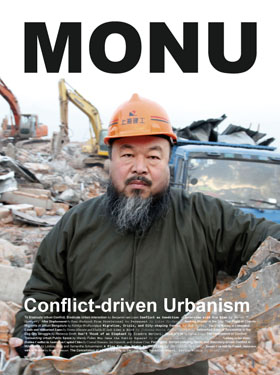






Order a copy of MONU #37 here.
(browse
the entire issue #37 on Youtube)
To Eradicate Urban Conflict, Eradicate Urban Interaction by Benjamin
van Loon; Conflict
as Condition - Interview with Eve Blau by
Bernd Upmeyer; After Displacement by Rana Abudayyeh;
From Provisional to Permanent by Lukas Großmann; Seeking
Shelter in the City: The Plight of Climate Migrants in Urban Bengaluru by
Kshitija Mruthyunjaya; Migration, Crisis, and City-shaping Forces
by Zoë Ritts; The [Un]Making of Communal Lands and Militarised
Zones by Niema Alhessen and Khalda El Jack; Like a Bird by
Johanna-Maria Fritz/OSTKREUZ; Networked Sites of Resistance in the Cop
City Struggle by Rebecca Smith; Don’t Think of an Elephant
by Diambra Mariani; Youth of Kyiv by Fabian Ritter;
The Persistence of Conflict: Transacting Urban Public Space by Wendy
Pullan; Who Owns the Public Square? by Stephanie Newcomb and Danijel
Losic; Nothing to See Here: Hidden Conflict in Australian Capital Cities
by Conrad Hamann, Ian Nazareth, and Graham Crist; Fair Fights: Gerrymandering,
Malls, and Boundary-driven Conflict in Milwaukee by Lindsey Krug and
Samantha Schuermann; A Plea for the Right to Conflict by Christina
Schraml; Beauty
Can Still Be Found - Interview with Ai Weiwei by
Bernd Upmeyer; The Cancellation of a Potential City by Carolina
Tobler; Paradise Found, Perils Within by Nishi Shah
“To Eradicate Urban Conflict, Eradicate Urban Interaction” as
Benjamin van Loon states in his satirical article that is structured
as a memo to the members of a fictitious association: the North American Alliance
for Gated Communities. Because urbanism is inherently conflict-driven as Eve
Blau points out in our interview with her entitled “Conflict
as Condition”. According to her, processes of urbanization involve
a certain amount of violence and destruction as cities are places of power,
representation, and contestation, which she thinks is both positive and negative.
How negative it may become is demonstrated by Rana Abudayyeh in
her contribution “After Displacement: Conflict-driven Urbanism and the
Shaping of the Syrian Refugee Narrative” in which she shows how the
onset of the Syrian Refugee Crisis in 2011 marked one of the largest conflict-driven
exoduses in modern times. She elucidates in what way refugees engage in the
reconstruction of their urban environments through “Conflict-driven
Urbanism”, concurrently reshaping their places and identities while
navigating the complex structures of belonging in the form of translocational
placemaking. Through this, “Conflict-driven Urbanism” can become
a catalyst for empowerment, enabling transient communities to assert agency
in temporal settings and unstable conditions. But not everyone can escape conflict,
either due to financial restraints or by choice, not wishing to abandon their
lands, and thus typically are left to fend for themselves as Niema Alhessen
and Khalda El Jack argue in their piece “The [Un]Making
of Communal Lands and Militarised Zones: Conflict-driven Urbanism in Al-Shajara,
Khartoum”. How the inhabitants that are left behind nevertheless manage
to create self- help practices is revealed in the article. One of the most effective
strategies involves the construction of so-called “emergency response rooms”
that have become lifelines for the hundreds who have remained, transforming
public and private buildings such as schools and homes into communal kitchens
and aid-centres tapping efficiently into the resources necessary to sustain
and create this new layer of “Conflict-driven Urbanism” within
these Sudanese neighbourhoods. Some of its practices shine as lights and symbols
of hope in conflicted regions, illustrating an alternative life like the one
that Johanna-Maria Fritz/OSTKREUZ offers in her photo-essay
“Like a Bird”, in which she presents circus cultures in countries
known for troubled politics and dire living conditions such as Iran, Afghanistan,
or Palestine. A similar optimism is tangible in the images of Fabian Ritter
that portray how the “Youth of Kyiv” is returning to the Ukrainian
capital engaging once again in theater rehearsals, organizing flea markets,
reuniting at the lake, and joining concerts. However, in many conflicted regions
solutions are elusive and we may simply have to learn how to live with certain
levels of conflict, accepting it as the price paid for diversity, as Wendy
Pullan argues in “The Persistence of Conflict: Transacting Urban
Public Space”. But for her a city is only a city when it encompasses
diversity, indicating that cities are both robust and delicate at the same time.
Therefore, if we wish to address the problem of conflict in cities, we must
recognise and play to the strengths of both these qualities and according to
her public space is one of the key ways to make this happen. Unless you aim
for remoteness and dispersal, both at a global scale and an urban scale: a tactic
to avoid conflict, or render it invisible, as Conrad Hamann, Ian
Nazareth, and Graham Crist suggest in “Nothing
to See Here: Hidden Conflict in Australian Capital Cities” referring
to sprawl and emptiness as a chief tool of protection, which comes probably
closest to the earlier mentioned anti-urbanism approach to conflict of van
Loon. However, as a lack of conflict, illustrated as the Australian
Dream by Hamann, Nazareth, and Crist,
can easily camouflage a machinery of inequality and environmental depletion,
with which affordability and sustainability are kept at a distance, a complete
absence of conflict appears to be never entirely positive either. Thus, Christina
Schraml argues in her contribution “A Plea for the Right to
Conflict” that conflicts should not be viewed merely as disruptive
but as essential and inevitable in society, playing a crucial role in preserving
democracy. The goal should not be conflict elimination but fostering methods
that sustain conflict as a productive state, transforming and re-imagining spaces
as more dynamic environments that embrace conflicts as an integral part of urban
coexistence. Conclusively, under most circumstances, conflicts cannot be definitively
classified as either destructive or constructive, as Ai Weiwei
wraps it up in the second interview entitled “Beauty Can Still Be Found”
emphasizing that, as a human being, the greatest challenge lies in addressing
the spiritual state of individuals within these conflicts. The goal should not
be to become a casualty of conflict, but to treat other lives and living environments
in a humane and benevolent manner. Consequently, Nishi Shah urges
in “Paradise Found, Perils Within” that architects, urban and
spatial planners - often dismissive of war-torn territories - must exhibit unparalleled
adequacy in addressing spaces of conflict as the initial step towards reimagining
an architecture for peace.
Bernd Upmeyer, Editor-in-Chief, October 2024
(Cover: Image is part of the Interview with Ai Weiwei on page 109
and courtesy of Ai Weiwei Studio. ©Ai Weiwei Studio)
This
issue is supported by The
Complete Guide to Combat City by Julia Schulz-Dornburg; The
Berlage - MSc in Architecture and Urban Design; Royal
Academy of Art the Hague - Master’s Programme Interior Architecture (INSIDE);
The Athletic Coup - Film
Festival; and
Incognita’s Architecture
Trips: Discover Eastern European Architecture and Urbanism. Find
out more about MONU's supporters in Support.
16-10-23
// MONU #36 - NEW SOCIAL URBANISM
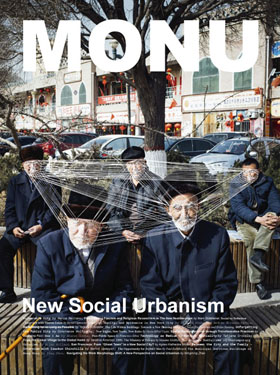






Order a copy of MONU #36 here.
(browse
the entire issue #36 on Youtube)
Vulnerable City by Maria Reitano; Free Floating Fascism and
Religious Revanchism is The New Neoliberalism by Mark Gottdiener;
Social
by Definition - Interview with Sharon Zukin by
Bernd Upmeyer; Density, Equity, and Epidemics in New York City
by Richard Plunz and Andrés Álvarez-Dávila; Do
Nothing for as Long as Possible by Tatjana Schneider; The Life
Within Buildings: Towards a New Housing Policy by Christoffer Jusélius
and Helen Runting; Unforgetting the Public City by Constanze Wolfgring;
New Rights, New Needs, New Rules by Nuria Ribas Costa; Spatial
Reappropriation through Transformative Practices by Valentina Rizzi;
New I Am by Bharat Sikka; Post-Public Space by Francisco Silva;
Technology as Medium to Rethink Spatiality by Tatjana Crossley;
From the Global Village to the Global Home by Serafina Amoroso;
2091: The Ministry of Privacy by Maxime Matthys; The Strange Bedfellows
of Contemporary Urbanism by Brian Holland; San Francisco: From
“Ghost Town” to a New Social City? by Agnes Katharina Müller;
Between
the City and the Family - Interview with Izaskun Chinchilla by
Bernd Upmeyer; The Opportunity for Joyful Cities by Paul Kalbfleisch;
The Municipal Services Buildings of Hong Kong by Ying Zhou; Navigating
the Work Morphology Shift: A New Perspective on Social Urbanism by Mingming
Zhao
How
is a “New Social Urbanism” possible if the hegemonic Western
paradigm of space production revolves around the antisocial principle of the
individualization of every aspect of life? asks Maria Reitano
in her piece “Vulnerable City”. According to her, long before,
during, and after the pandemic, individualization and competitiveness define
the (anti)social consistence of the Western neoliberal city. Following Mark
Gottdiener and his contribution “Free Floating Fascism and Religious
Revanchism is The New Neoliberalism: Challenges for Architects and Urban Planners”
we have entered a new phase of global destabilization amplifying social deficits
after Neoliberalism’s dismantling of social institutions has been shown
to have critically injured the structure of society leading to aggravated and
extreme social problems. Sharon Zukin, too, is rather pessimistic about whether
a “New Social Urbanism” is rising, as she states in our interview
with her called “Social by Definition”, pointing out that even
cities like New York are increasingly unable to pay for and to respond to people’s
needs for housing, healthcare, and education. Richard Plunz and
Andrés Álvarez-Dávila confirm the dire housing
situation in their article “Density, Equity, and Epidemics in New York
City”, in which they emphasize that, after numerous attempts, the economics
of housing production in New York today shows no capacity for producing affordable
housing and that the most recent health crisis has only aggravated pre-existing
socio-economic and racial disparities in housing insecurity. However,
Tatjana Schneider challenges us in her contribution “Do Nothing
for as Long as Possible” to engage with what causes these conditions,
arguing that the critique is there, the analysis too, and that there are therefore
hopeful rifts and cracks. Because we already have many of the tools and the
infrastructures needed to challenge the unequal, cynical, and anti-social system
in which we operate as planners, as Christoffer Jusélius
and Helen Runting clarify in “The Life Within Buildings:
Towards a New Housing Policy”, but what we do not have - yet - is the
collective will to fully utilize these resources. That is why we need to revive
a sense of solidarity and shared responsibility, an ethics that constitutes
a necessary foundation for the hard work that will be needed to create inclusive
cities. Nuria Ribas Costa reminds us in her article “New
Rights, New Needs, New Rules” that such ethics can be stimulated and
supported by the implementation of collaborative and grassroots conflict-solving
and decision-making institutions, as “New Social Urbanism”
is not only about how the city is lived, but also how it is owned and governed.
Thus, envisioning a “New Social Urbanism” requires a thoughtful
consideration of participatory co-constructed strategies that revitalize the
urban and social fabric, providing an organic pathway for community development,
as Valentina Rizzi puts it in “Spatial Reappropriation
through Transformative Practices”. Her research presents case studies
that intervene in the urban realm by combining visual arts and performative
arts with the architecture of bodies and spaces, aiming to create transformative
experiences of rupture, experiences that are mysteriously graspable in the images
of Bharat Sikka’s series of photos entitled “New
I Am”. But today our urban realm and our public spaces have expanded
due to recent technological progress into the digital domain too, enabling possibilities
for human relationships that were once out of reach as Francisco Silva
points out in “Post-Public Space”. According to him, social
spaces can become places of reunion that are driven by a design focused on the
complexity of the human connection. In a merger of body, technology, and all
the structures that surround them, public spaces may finally find a tabula rasa
that allows them to return to their very essence - the pleasure of connection.
By uploading the photographs of the everyday lives of the inhabitants of one
of the last remaining bastions of Uyghur culture in Kashgar into facial recognition
software and by rendering the resulting biometric data directly onto the subjects’
faces, Maxime Matthys illustrates with his project “2091:
The Ministry of Privacy” what such a merger of body, technology, and
surrounding structures might look like. One way of understanding mergers like
these is through the concept of hybridisation. To do so, Brian Holland
introduces in his piece “The Strange Bedfellows of Contemporary Urbanism”
practices to which he refers as “piggybackings” that at their best
create surprising entanglements that provoke hybrid forms and programs of social
exchange capable of promoting greater equity and diversity in the built environment.
For Holland the piggybacking practices that he presents illuminate
an important form of social entrepreneurialism in contemporary urban life contributing
to a “New Social Urbanism”. When asked about the future of
social urbanism, Izaskun Chinchilla, too, believes that we are
heading toward a hybrid situation in which we will socialize both physically
and digitally, multiplying the spectrum of the ways of meeting and socializing,
as she explains in our second interview entitled “Between the City and
the Family” stressing the importance of the neighbourhood for a “New
Social Urbanism”. And as the demarcation between home and work increasingly
dissipates, architects, urban designers, and urban planners might be motivated
to conceive more “third spaces” in cities, which are public locations
equipped with amenities to serve as communal workspaces, from parks and libraries
to cafes and community hubs, as Mingming Zhao forcasts in “Navigating
the Work Morphology Shift: A New Perspective on Social Urbanism”.
She envisions a decentralized city, where technological progression and human
comfort are intertwined, shaping an urban environment that feels simultaneously
futuristic and familiar. We never know what new forms will emerge out of that,
although if you think about democracy in a city as a role model, it is always
very messy, as Zukin states, but according to her this may be
what “New Social Urbanism” is all about.
Bernd Upmeyer, Editor-in-Chief, October 2023
(Cover: Image is part of Maxime Matthys’ contribution “2091:
The Ministry of Privacy” on page 84. ©Maxime Matthys; Music: Queen
- I Want to Break Free, Video editing: Danae Zachariaki)
This
issue is supported by The
Berlage - The Berlage Center for Advanced Studies in Architecture and Urban
Design; From
‘Urban Andes’ to ‘Politics in the City’! New Architecture
& Urban Planning Books from Leuven University Press; Rotterdam’s
Independent School for the City: A 12-week full-time Education Programme on
Contemporary Urbanism, Dealing with Right to the City, Climate Change and Superdiversity;
and
Incognita’s Architecture
Trips: Discover Eastern European Architecture and Urbanism. Find
out more about MONU's supporters in Support.
17-10-22
// MONU #35 - UNFINISHED URBANISM
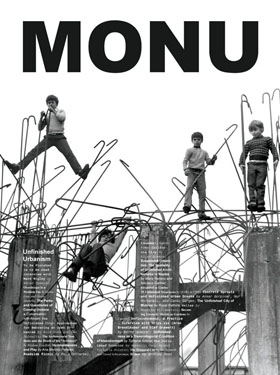






Order a copy of MONU #35 here.
(browse
the entire issue #35 on Youtube)
To Be Finished Is to Be Dead -
Interview with Mark Wigley by Bernd
Upmeyer; Overdesign Is a Problem Too by Marco Enia and Flavio
Martella; The Perks and Quandaries of Coming Undone a Conversation
with Akoaki; The Unfinished City: Approaches for Embracing an Open Urbanism
by Nick Dunn and Dan Dubowitz; The Architectural Non-finito and the
Death of the “Architect” by Wijdane Esseffah; Incompleteness
and Play by Ana Morcillo Pallares; Roadside Picnic - Remote Detour
around the World’s Unfinished Nuclear Power Plants by Paul Cetnarski;
Unsettled by Isabelle Pateer; California City by Elian
Somers; Suspended Urbanities: The Spatiality of Unfinished Architectures
in Naples by Maria Reitano and Nikolaus Gartner; Stranded in Limbo:
25 Unfinished Structures by MARS at PBSA; Concrete Sprouts and
Unfinished Urban Dreams by Avsar Gürpinar, Nur Horsanal, and Cansu
Cürgen; The ‘Unfinished’ City of Mumbai by Rupal
Rathore; Hellas by Maarten Willemstein; Becoming Unstuck:
Streets as Gardens, with the Disposition for Ongoing Experimentation by
Dan Hill; Unfinishedness, a
Practice - Interview with bplus.xyz (Arno Brandlhuber and Olaf Grawert) by
Bernd Upmeyer; Unfinishedness as a Transcategorial Condition of Abandonment
by Tiphaine Abenia; The Unfinished Interior by Marcello Carpino
and Vittoria Poletto; The Temporal City by Ian Nazareth and David
Schwarzman; Ordos by Anthony Reed
“To Be Finished Is to Be Dead” claims Mark Wigley
in our interview with him. Because only an unfinished city is a city that is
open to unknown and unpredictable transactions and that is what cities are for.
To him, urbanism is only urbanism to the extent that it is unfinished and “Unfinished
Urbanism” an urgent call in an age of a pandemic and of predictability,
both of which are killing us. According to Marco Enia and
Flavio Martella a living city can actually never be finished, because
by their very nature cities are unfinished organisms. As long as they are home
to a living community, cities will constantly readjust to meet its needs and
desires and only stop changing when they start to decay and vice versa. “Unfinishedness”
allows for complex forms of appropriation and participation, creating a stronger
bond with the city as they state in their contribution “Overdesign Is
a Problem Too”. Thus, only with an open urbanism that is intentionally
incomplete can we design cities that are equitable and sustainable as Nick
Dunn and Dan Dubowitz describe the idea in their piece
“The Unfinished City: Approaches for Embracing an Open Urbanism”.
If cities are overly finished and too confined they stagnate and exclude, sharpening
further existing inequalities while simultaneously using up precious resources,
which is ludicrous in an era of climate emergency. To avoid this we need to
support the creativity of the authentic (the “uncompleted”) as opposed
to the rampant creativity of the exact (the completed) explains Ana Morcillo
Pallares in her article “Incompleteness and Play”.
She recalls an ethos pushed by a cohort of Italian architects and designers
active from the late 1960s through the 1970s who were known as the Italian Radical
Architecture and who tried to overcome the urbanistic failures of the “completed”
plans of the 20th century through talking, listening and social practice. However,
following the arguments of Paul Cetnarski in his piece “Roadside
Picnic - Remote Detour around the World’s Unfinished Nuclear Power Plants”
we reached a point in our civilisation where certain elements of our built environment
cannot be erased, making “Unfinished Urbanism” more of a burden
than an achievement. As a result, the uncertainty of “unfinishedness”
can endanger the lives and existences of people in urban areas too as Isabelle
Pateer shows in her photo-essay “Unsettled” in which
she investigates the evolution of the Antwerp harbour expansion zone in Belgium
illustrating how the inhabitants, their environment and surroundings, as well
as their social fabric are affected by these large alterations. Therefore,
“Unfinished Urbanism” can cause many problems too, especially
when architectures become abandoned ruins within construction sites waiting
for someone to finish them as Maria Reitano and Nikolaus
Gartner point out in “Suspended Urbanities: The Spatiality of
Unfinished Architectures in Naples”. They argue that when no urban
strategies deal with such unfinished architectures – which has been referred
to as “Incompiuto” and even as a new Italian architectural style -
they become inaccessible, turning into spatial gaps, interruptions within the
urban fabric and the peri-urban landscape, and fragmenting the urban public
space. Yet Maarten Willemstein, in his series of images entitled
“Hellas”, shows similar unfinished architectures, though in Greece.
He does not want to present them merely as dilapidated buildings, but as echoes
of the old classical Greek temples and as structures that are at the beginning
of their ‘life’, neither as abandoned ruins nor at the end of their
existence providing hope for a possible future. Such optimism when it comes
to ‘ruins’ is shared by bplus.xyz (Arno Brandlhuber and Olaf
Grawert), who introduce “Unfinishedness, a Practice” in
our second interview: the possibility of a new urban regulation that does not
differentiate between office, housing, or commercial functions anymore, but
considers buildings as so-called ‘intelligent ruins’ that are thought,
designed, and built in a way to be adapted and reused in the future, enriching
the discussion on architecture and “unfinishedness” on a legislative
level. Through such functional resistance, Tiphaine Abenia sees
a hopeful disconnection and an invitation to reconcile “unfinishedness”
with a practice of freedom. Like Willemstein she is not interested
in the aesthetical fascination and romanticising of decay, which tends to freeze
the phenomenon into a necrotic image, but in the dynamic process inherent in
abandonment. In other words, she is interested in its “unfinishedness”
as she declares in “Unfinishedness as a Transcategorial Condition of
Abandonment”. Consequently, “Unfinished Urbanism”
might further reconcile the known and the unknown as Ian Nazareth
and David Schwarzman conclude in their contribution “The
Temporal City” creating spaces in which people according to Anthony
Reed and his contribution “Ordos” might feel estranged
but never lost.
Bernd Upmeyer, Editor-in-Chief, October 2022
(Cover: Image is part of
Ana Morcillo Pallares’s contribution “Incompleteness and Play”
on page 39. Photograph by Riccardo Dalisi (Courtesy of Archivio Dalisi /
Napoli, Italy) Music: Limahl - Never
Ending Story, Video editing: Danae Zachariaki)
This
issue is supported by The
Berlage - The Berlage Center for Advanced Studies in Architecture and Urban
Design; Estonian
Academy of Arts (EKA): Urban Studies MSc; KU
Leuven’s Master of Human Settlements and Master of Urbanism, Landscape
and Planning; Rotterdam’s
Independent School for the City:
Dirty Old Town; Learning From Rotterdam - A Unique 12-week Post Graduate Education
Programme; and Incognita’s
Architecture Trips: Discover Eastern European Architecture and Urbanism.
Find out more about MONU's supporters in Support.
18-10-21
// MONU #34 - PROTEST URBANISM
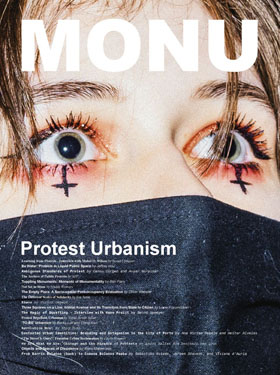






Order a copy of MONU #34 here.
(browse
the entire issue #34 on Youtube)
Learning from Protests - Interview
with Mabel O. Wilson by
Bernd Upmeyer; Be Water: Protests in Liquid Public
Space by Jeffrey Hou; Ambiguous Standards of Protest by
Cansu Cürgen and Avsar Gürpinar; The Archive of Public
Protests by APP; Toppling Monuments: Moments of Monumentality
by Ben Parry; Not Set in Stone by Maddy Weavers;
The Empty Plaza: A Socio-spatial Post-occupancy Evaluation by
Dillon Webster; The Different Scales of Solidarity by Ece
Yetim; Khaos by Ulrich Lebeuf; Three Squares
on a Line: Istiklal Avenue and Its Transition from State to Citizen by
Liana Kuyumcuyan; The Magic
of Squatting - Interview with Hans Pruijt
by Bernd Upmeyer; Protest Repellant Urbanism by
Nurul Azreen Azlan; 'TO-BE' Urbanism by Becky Luk and Ching
Kan; Revolution Now! by Bing Guan; Contested
Urban Identities: Branding and Antagonism in the City of Porto by Ana
Miriam Rebelo and Heitor Alvelos; "The Street Is Ours":
Feminine Urban Reclamation by Cécile Houpert; We
Are What We Are: Chicago and the Paradox of Protests by Aaron Kalfen
and Benjamin van Loon; Objects and Spaces of Dissidence by
Mario Matamoros; From Barrio Bolaños (back) to Comuna Bolaños
Pamba by Sebastián Oviedo, Jeroen Stevens, and Viviana d'Auria
Even though
our social media age marks a shift in form and forum, when it comes to "Protest
Urbanism" there still seems to be a need for - and validity of - having
physical bodies in a public space in order for a protest to have an effect,
as Mabel O. Wilson argues in our interview "Learning from
Protests". Bodies occupying large spaces or marching through different
types of arteries, be it streets or freeways, still appear to be central tactics
for people engaging in political protest. It is the visceral encounters in physical
spaces that trigger deeper and more emotional connections as Jeffrey Hou
states in his contribution "Be Water: Protests in Liquid Public
Space". For Cansu Cürgen and Avsar Gürpinar
physicality matters too as they demonstrate in their piece "Ambiguous
Standards of Protest", introducing real objects of protest into the
discussion, such as bananas, hoodies, bras, and cloth hangers that became the
symbols of the abortion protests in Poland in 2016. According to them these
objects set the ambiguous standards of protest, becoming objects of Protest
Urbanism. In APP's photo-series "The Archive of Public
Protests" we get a glimpse of how objects such as cloth hangers were
actually used during the Polish protests, which became the largest protests
in the country's contemporary history. Being part of a printed "Strike
Newspaper" the photographs can become a banner in your hand, a poster on
a building, or a picture on a wall providing tangible objects, thus offering
more than just internet circulation and silent contemplation. However, as Ben
Parry points out in "Toppling Monuments and Moments of Monumentality",
protests often gather force at the global scale especially via the creation
and circulation of powerful media images, Internet memes, and creative expressions
of solidarity leading to powerful relations between physical public space and
digital public space - the traditional and electronic agora. On the other hand,
the notion of designing physical public spaces for protests might require a
critical review, Dillon Webster demands in "The Empty
Plaza: A Socio-spatial Post-occupancy Evaluation", as protests mostly
happen with no regard to, and likely consciously against, intentionally allocated
spaces for activism. In his article he presents an example of how designs were
rejected by protesters revealing that protests are an improvisational performance
in which actors respond to temporal and physical cues, collectively reaching
a destination. With his dark and grainy images of the French Yellow Vests protests
Ulrich Lebeuf tries in his piece "Khaos" to review
the perception of protests too, aiming to rewrite history and not only to inform
but also to question. An answer to the question of how urban spaces and even
city planning might be influenced by protests is provided by Hans Pruijt
in our second interview called "The Magic of Squatting" showing
how squatting as a form of protest and as "direct action" achieved
to preserve the 19th-Century street grid of a neighbourhood in Amsterdam changing
the urban planning of the city accordingly. In the interview Pruijt
further emphasises the important role architects, urban designers, urban planners,
and other stakeholders in our cities can play in shaping, defining, and limiting
protests. He sees a particularly strong connection between architecture and
squatting in a squatted old salami factory called "Metropoliz" on
the outskirts of Rome. To what extent cities can shape or repel protests and
how the very materiality of urban space may be employed to suppress dissent,
is examined by Nurul Azreen Azlan in her piece "Protest
Repellant Urbanism" pointing out the example of Baron Hausmann's restructuring
of the Parisian urban form. Hausmann's big boulevards that cut through the medieval
urban fabric had made it difficult for protesters to build barricades, that
infamous spatial tactic synonymous with the revolutions in Paris, while making
it easier for the police to disperse the crowds. Notwithstanding the power of
cities, according to Becky Luk and Ching Kan protests
can become breeding grounds for the evolution of urban agencies, as they explain
in "'TO-BE' Urbanism". The urban agencies that emerged especially
in Hong Kong demonstrate how un-addressed and un-fulfilled claims from protests
can readily transform into the most persistent and adaptable energy for long-term
urban action. Their creation becomes an infrastructure to counter the existing
system and co-create a more democratic system for urban production. In that
way protests can serve fundamental democratic functions, as Aaron Kalfen
and Benjamin van Loon put it in "We Are What We Are: Chicago
and the Paradox of Protests" analysing how protests function as organisms
within the larger urban theatre. Following Sebastián Oviedo,
Jeroen Stevens, and Viviana d'Auria in "From
Barrio Bolaños (back) to Comuna Bolaños Pamba" Protest
Urbanism emerges thus ideally not merely as protest against a certain form
of authoritarian urbanism, nor as simply a spatial form of opposition, but as
a highly heterogeneous call for the reconstitution and recognition of fundamentally
'plural' and relational forms of making and inhabiting the city.
Bernd Upmeyer, Editor-in-Chief, October 2021
(Cover: Image is part of APP’s contribution “The Archive
of Public Protests” on page 30. ©Rafal Milach)
This
issue is supported by
Material District´s
Book: Tomorrow’s Timber, Lucerne
University of Applied Sciences And Arts: Master Studies in Architecture in Switzerland,
Estonian
Academy of Arts (Eka): Urban Studies MSc, Rotterdam’s
Independent School for the City: Dirty Old Town; Act Now! - A Unique 12-week
Post Graduate Education Programme, and University
of Basel: Master of Arts - Critical Urbanisms. Find out more about MONU's
supporters in Support.
19-10-20
// MONU #33 - PANDEMIC URBANISM
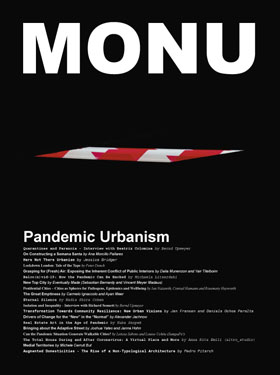






Order a copy of MONU #33 here.
(browse
the entire issue #33 on Youtube)
Quarantines and Paranoia - Interview with Beatriz Colomina by Bernd
Upmeyer; On Constructing a Semana Santa by Ana Morcillo Pallares;
Here Not There Urbanism by Jessica Bridger; Lockdown London:
Tale of the Tape by Peter Dench; Grasping for (Fresh) Air: Exposing
the Inherent Conflict of Public Interiors by Dalia Munenzon and Yair
Titelboim; Balco(n)vid-19: How the Pandemic Can Be Hacked by Michaela
Litsardaki; New Top City by Eventually Made (Sebastian Bernardy
and Vincent Meyer Madaus); Pestilential Cities - Cities as Spheres for
Pathogens, Epidemics and Wellbeing by Ian Nazareth, Conrad Hamann and
Rosemary Heyworth; The Great Emptiness by Carmelo Ignaccolo and
Ayan Meer; Eternal Silence by Nadia Shira Cohen; Isolation
and Inequality - Interview with Richard Sennett by
Bernd Upmeyer; Transformation Towards Community Resilience: New Urban
Visions by Jan Fransen and Daniela Ochoa Peralta; Drivers of Change
for the "New" in the "Normal" by Alexander Jachnow;
Real Estate Art in the Age of Pandemic by Kuba Snopek; Bringing
about the Adaptive Street by Joshua Yates and Janna Hohn; Can
the Pandemic Situation Generate Walkable Cities? by Leticia Sabino and
Louise Uchôa (SampaPé!); The Total House During and After
Coronavirus: A Virtual Place and More by Anna Rita Emili (altro_studio);
Medial Territories by Michele Cerruti But; Augmented Domesticities
- The Rise of a Non-Typological Architecture by Pedro Pitarch
One of the most important influences of the current global coronavirus pandemic
on cities might be the fact that it has made the invisible city visible: the
enormous economic inequities and unequal access to healthcare and to education,
as Beatriz Colomina points out in our conversation with her on
“Quarantines and Paranoia”. She further states that the pandemic
surely influenced our perception of cities, especially when during the lockdown
there was less traffic and the urban background became much more visible which
allowed the buildings to appear in a completely new way, beautifully and with
so much previously unnoticed details. The entire city was looking very different.
The bustle, the scene, the very vibe itself nearly vanished overnight in nearly
every city as Jessica Bridger depicts the change in her contribution
“Here Not There Urbanism”, explaining that suddenly people
could recognise all of the grocery store employees, where before city blindness
had rendered them anonymous. According to her, Covid-19 uncloaked the urban
invisible just as it put down 2-meter distance markers on sidewalks, subway
platforms, and shop-floors. Peter Dench recognised a similar effect
in central London’s red-and-white-striped hazard tape - draped across park
benches, wrapped around exercise equipment, adorning statues and forming screens
to protect bus drivers - showing the familiar in the city in a different way
in his photo-essay “Lockdown London: Tale of the Tape”. In
their article “The Great Emptiness” Carmelo Ignaccolo
and Ayan Meer point out that in the urban silence of Rome, the
only sound perceived at the Trevi Fountain was its own cascading water, arguing
that with global travel restrictions put in place to curtail the coronavirus
pandemic, tourists have become the first pandemic-induced extinct species bringing
the tourism industry to a complete halt. How cities will get on without tourism
is a question also raised by Richard Sennett during our interview
with him entitled “Isolation and Inequality”. According to
him one permanent impact of the pandemic will be economic, which will become
especially obvious in big cities. He further believes that to deal with crises
such as the current pandemic, we need to create more flexible urban environments
with decentralised nodes of concentration that can be reached within fifteen
minutes. In relation to this Alexander Jachnow reintroduces the
idea of the pocket city into the discussion, given the apparent advantages of
such a layout: small, walkable neighbourhoods are more introverted, hence less
connected and less vulnerable to the spread of disease. However, although such
possibilities of responsive planning patterns are undisputed, he considers their
implementation rather unlikely expecting little change in the creation of cities
due to the pandemic as he argues in his piece “Drivers of Change for
the “New” in the “Normal””. Nevertheless, for Joshua
Yates and Janna Hohn the Covid-19 Crisis provides an opportunity
to fundamentally change urban street-spaces as parts of a liveable, resilient
city, which has so far taken the form of temporary ad-hoc measures, but these
same measures might have the potential to develop into a form of ‘tactical
urbanism’ for long-term change, as they explain in their article “Bringing
about the Adaptive Street”. Other changes might be triggered by technology.
In her piece “The Total House during and after Coronavirus: A Virtual
Place and More” Anna Rita Emili states that the catastrophe
generated by Covid-19 has actually accelerated the globalisation of virtual
intelligence, and that in the era of the Internet the meaning of our world increasingly
requires the use of tools, platforms, and infrastructures linked to the Internet.
This phenomenon does actually lead to a transformation of social relationships
into virtual entities, but does not drag the individual towards isolation. Yet,
Sennett sees social isolation increasing - another important
effect of the pandemic. In relation to virtual spaces Pedro Pitarch
emphasises in “Augmented Domesticities: The Rise of a Non-Typological
Architecture” that while work and home have been opposite spheres in
modern life, in the contemporary city - and due to the Covid-19 Crisis - digital
technologies have generated a medium that constantly mediates between both,
establishing much more complex situations and conditions where new ‘publicness’
is achieved and performed. Living-rooms become offices, garages function as
DIY industries, bedrooms perform as TV sets, corridors as gyms, kitchens as
playgrounds, and balconies as plazas. Colomina, too, believes
that the fact that we are doing so many more things from home than previously,
which might continue after the crisis, will have huge consequences for our cities.
It may even put an end to the division between the “city of rest”
and the “city of work” which only emerged with industrialisation.
In particular - because people increasingly work from home - this will create
a significant transformation in the ways we live and might make the idea of
big office towers and the city of business obsolete, which means that we have
to think the city differently. Nonetheless, Jachnow reminds us
that cities are complex adaptive systems, capable of producing solutions to
the challenges they face and that we should be confident that through responsible
collective behaviour of individuals we will overcome not only the threats of
the pandemic, but find ways to better deal with the current distressing precautions.
And if it could be coupled, as Bridger demands, with the urgently
needed responses to the coming climate crisis - for her the crisis to end all
crises - then Covid-19 will provide more than a silver lining. It will be the
foundation for a new kind of shining, silver city upon a hill.
Bernd Upmeyer, Editor-in-Chief, October 2020
(Cover: Image is part of Peter Dench’s contribution “Lockdown
London: Tale of the Tape” on page 27. ©Peter Dench)
This
issue is supported by Lucerne
University of Applied Sciences and Arts' Master Studies in Architecture in Switzerland,
CIVA´s
Exhibition: Superstudio Migrazioni, Stroom
Den Haag’s Exhibition: Capturing Corona. The Lockdown in Photos and
Rotterdam’s
Independent School for the City’s Three-month Educational Programme on
Contemporary Urbanism. Find out more about MONU's supporters in Support.
20-04-20 // MONU #32 – AFFORDABLE URBANISM
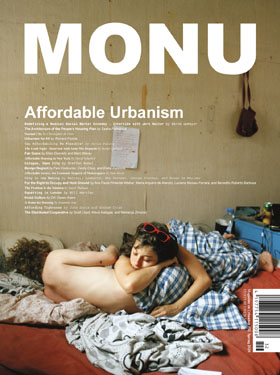






Order a copy of MONU #32 here.
(browse
the entire issue #32 on Youtube)
Redefining
a Radical Social Market Economy - Interview with Jörn Walter by
Bernd Upmeyer; The Architecture of the People’s Housing
Plan by Sasha Plotnikova; Normal City by Christopher de
Vries; Urbanism for All by Richard Florida; Can Affordability
Be Flexible? by Savia Palate; The
Good Fight - Interview with Anne Mie Depuydt by
Bernd Upmeyer; Fair Game by Ellen Donnelly and Marc
Maxey; Affordable Housing in New York by David Schalliol;
Cologne, Open City by Steffan Robel; Benign Neglect by
Fani Kostourou, Cecily Chua, and Elahe Karimnia; Affordable Access: the
Economic Impacts of Makerspaces by Nate Bicak; City in
the Making by Matthias Lamberts, Ken Vervaet, Jeroen Stevens, and Bruno
De Meulder; For the Right to Occupy and Hold Ground by Ana Paula
Pimentel Walker, María Arquero de Alarcón, Luciana Nicolau Ferrara,
and Benedito Roberto Barbosa; The Problem Is the Solution by
Tanzil Shafique; Squatting in London by Will Hartley; Kiosk
Culture by DK Osseo-Asare; A Home for Housing by Jonathan
Tate; Affording Tightness by John Doyle and Graham Crist;
The Distributed Cooperative by Scott Lloyd, Alexis Kalagas, and Nemanja
Zimonjic
The creation of affordable urban spaces - whether for housing, work spaces,
public spaces, urban infrastructure, or other functions - is a complex issue,
as cost considerations must be balanced with other important objectives such
as social usability, environmental sustainability, beauty, etc. Because, as
the former Chief Planning Officer of the city of Hamburg, Jörn Walter,
argues in our interview “Redefining a Radical Social Market Economy”:
none of this is worth anything if people cannot pay for it. Following Christopher
de Vries in his contribution “Normal City”, urbanization
and gentrification have become synonymous to such an extent that they seem inescapably
paired. Global cities such as New York, Tokyo, Berlin, London, and Paris, whilst
at the centre of our collective urban imagination, appear increasingly elitist
instead of representing shared societal ideals. Although there is much evidence
that cities have predominantly been elitist over the course of history, over
the last centuries cities have transformed into beacons of civic pride, national
self-image, and stages for an increasingly inclusive democratic society, a legacy
that is under threat, according to de Vries. Thus he investigates
the ‘Normal City’ to heal our broken system, creating places not as
refuges for cosmopolitan elites, but as places of shared identity and belonging
that can represent the normal distribution of the larger urban reality. In his
piece “Urbanism for All” Richard Florida outlines
some strategies for producing a more inclusive urbanism, reflecting questions
about uneven urban development, in order to find concrete paths to improve urban
life for all, yet still believing in the value of the creative class as an engine
for economic prosperity in cities, but not as an isolated strategy. For Anne
Mie Depuydt, in our second interview entitled “The Good Fight
- Towards a Popular, Original and Productive City”, to create more
inclusive and affordable cities, municipalities need to find new ways to achieve
affordable housing, stressing the fact that people should only become the owner
of the bricks and mortar but not of the plot, meaning of the building, but not
of the land, referring to countries such as Switzerland and the UK, where such
a system exists. This provides the municipalities with advantages such as the
increase in tax revenue and an extra bargaining tool in seeking to incentivise
certain land use, as de Vries explains using the case of the Netherlands
and especially Amsterdam, where this system exists too, although currently under
threat of being scaled back or even abolished. Depuydt emphasises
further that in order to create more affordable housing, there are - apart from
the more obvious and established solution of constructing more units, the provision
of subsidies, or the implementation of rent-controls - many things architects
still need to improve, such as re-thinking our living and working spaces. To
demonstrate that affordable housing can take many forms - from cooperatives
that are collectively owned by the residents to not-for-profit developments
that rent out units at below-market rates, to public-private partnerships that
reduce the prices of single-family homes - was the idea behind David Schalliol’s
“Affordable Housing in New York” project, providing a fuller
representation of public housing in the United States and chronicling the history
of a wide variety of affordable housing models in the country’s largest
city. How diverse and vital affordable spaces for work can be, especially in
a socio-economic sense, is shown by Fani Kostourou, Cecily
Chua, and Elahe Karimnia in their article “Benign
Neglect” bringing London’s railway arches into the discussion
that are used – due to benign negligence by landowners, developers, and
the planning systems - by artists, artisans, mechanics, craftsmen, and other
businesses so they continue their productive existence within the city. These
activities present themselves as resistance to - and counter-strategy to - top-down
planning policies and neoliberal market forces resonating with a Lefebvrian
plea for rights to the city, as exemplified by the occupation movements of residual
spaces across the urban fabric of São Paulo that are brought to our attention
by Matthias Lamberts, Ken Vervaet, Jeroen
Stevens, and Bruno De Meulder in their piece “City
in the Making”. These urban movements show a valuable capacity to guide
and integrate those missing out on proper shelter. How chaotic and difficult,
but at the same time beautiful and intimate it can be when people try to claim
their right to have a roof over their head and a place to sleep at night, is
illustrated by Will Hartley in his photo-essay “Squatting
in London”. In order to make more of our city-spaces available and
affordable, Jonathan Tate reminds us - in his contribution
“A Home for Housing” - to reengage with the things that we have
left behind to the less inspirational sectors of the market, and that there
are cracks in every system and holes in every market through which design can
appear to become a generative endeavour instead of merely a decorative art,
as he shows using some vacant odd-sized lots in New Orleans that put creativity
at the start of the process. In their article “The Distributed Cooperative”
Scott Lloyd, Alexis Kalagas, and Nemanja Zimonjic
focus on ‘odd lots’ too, here in the city of Zürich, which represent
unrealized opportunities for smart densification, exploring strategies for re-imaging
a mixed-use cooperative housing development, conceived at a neighbourhood scale,
and distributed across multiple networked locations. In resisting global shifts
towards the treatment of space as an exclusive commodity in order to generate
affordable urban spaces, they intend to strengthen the community and eke out
more marginal financial gains through trade-offs, compelled by the systems of
capital that shape our cities. However, in order to produce more affordable
cities it may still be necessary to re-think capitalism, as Walter
states, but invent a radically new social market economy since all planned economy
counter-models of the 20th Century failed.
Bernd Upmeyer, Editor-in-Chief, April 2020
(Cover: Image is part of Will Hartley’s contribution “Squatting
in London” on page 97. ©Will Hartley)
This
issue is supported by European
Post-master in Urbanism (EMU) - Strategies and Design for Cities and Territories,
Bauhaus-University
Weimar’s International Master Course: Integrated Urban Development and
Design and Incognita’s
Architecture Trips: Discover Eastern European Architecture and Urbanism.
Find out more about MONU's supporters in Support.
14-10-19 // MONU #31 - AFTER
LIFE URBANISM
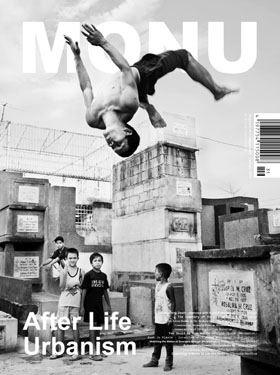






Order a copy of MONU #31 here.
(browse
the entire issue #31 on Youtube)
Democratizing
Death - Interview with Karla Rothstein by
Bernd Upmeyer; The Cemetery of the Living by Miguel Candela;
With Seven Bodies in My Backyard by Omar Kassab and Mostafa Youssef;
Constructing Memorial Poles as Monuments by David Charles Sloane;
Ghost Life Urbanism by Jérémie Dussault-Lefebvre and Sébastien
Roy; Death and Burial: In the Past Lies the Future by Carlton
Basmajian and Christopher Coutts; Beyond the Grave: Conscious Consumption
in Life and Death by Sybil Tong; Cemetery and Crematorium Futures
by Julie Rugg; The Silent City by Nicole Hanson; You
Could Be Compost by Katrina Spade (Recompose); Mourn by
Nienke Hoogvliet; Rest
in Pixels - Interview with James Norris by
Bernd Upmeyer; Watching the Wakes of Strangers through the Internet
by Andréia Martins van den Hurk; Suburban Halloween Decorations
by Cameron Jamie; Set in Stone: Humans and Barre Granite by
Monica Hutton; Claim Domain: An Urban Case for Burial by Anya
Domlesky; Exuberance and Resistance by the Dead by Bruno De Meulder
and Kelly Shannon; Coexisting: A Matter of Life and Death by Elissaveta
Marinova
To face the
urban challenges and phenomena that present themselves due to recent changes
in our society that are related to death, and its consequences for cities and
buildings, a topic that we call “After Life Urbanism”, “we
need to be simultaneously pragmatic and visionary” according to Karla
Rothstein in our interview with her entitled “Democratizing
Death”. She urges the re-engagement and coexistence with life and death
to explore what impacts all these transformations might have, encompassing first
of all spatial, but also cultural, social, environmental, technological, and
economic aspects. With his images of cemeteries of the city of Manila in the
Philippines, where families do not tread in fear of the “wrath” of
the dead but some found a place to call home among the crypts of the dead, Miguel
Candela depicts and symbolizes in his contribution “The Cemetery
of the Living” such coexistence of life and death. Omar Kassab
and Mostafa Youssef take this thought even further in their piece
“With Seven Bodies in My Backyard” arguing that the idea of the
cemetery as an apparatus of isolating death, as a form of escapism from the
reality of our own mortality, is deemed obsolete and propose to eradicate the
cemetery as a territorial land-use entirely, dispersing it throughout the city
leading to a dissolving of the cemetery. How places for mourning can be scattered
around the city is demonstrated by David Charles Sloane in his
piece “Constructing Memorial Poles as Monuments”, suggesting
to use poles, trees, and fences as “Everyday memorials” in the public
realm. That could be an innovative way to approach the problem that in the near
future many urban cemeteries will fill up, and few have room for expansion.
However, Carlton Basmajian and Christopher Coutts
see human burial, with an emphasis on natural burial instead of cremation and
the burying of embalmed bodies, as a vehicle for long-term land conservation
and restoration, and for an emotional reconnection to the eternal rhythms of
life, death, and remembrance, as they put it in their article “Death
and Burial: In the Past Lies the Future”. According to Julie
Rugg cemeteries contribute to the city a unique kind of landscape that
is highly beneficial to mental health as these are places where it is not regarded
as unusual to be solitary, and to enjoy quiet reflection, contributing emotional
intelligence to the cityscape, as she argues in “Cemetery and Crematorium
Futures”. But as long as humans continue to be buried in the ground,
whether in a beautiful and meaningful way with intentions of “placemaking”
or not, urban challenges and limitations such as the creation of affordable
housing or the construction of dense and compact cities, to name just a few,
will remain, and will require new ideas. One pioneering approach might come
from Katrina Spade and her company Recompose that
offers trailblazing burial and cremation alternatives having developed a system
that transforms a body into soil in approximately one month as a new sustainable
death-care option that has been legalized in Washington State recently, as is
explained in her contribution “You Could Be Compost”. That
technology can also introduce creativity to the discussion is revealed by James
Norris, who is the founder of the end of life planning software “MyWishes”,
in our second interview entitled “Rest in Pixels”. On MyWishes
users can plan for death, their funeral, can say their final goodbyes, and post
pre-designed content, such as updates, pictures, and comments, at defined intervals
or on certain important dates or anniversaries after their death. That information
technology, especially in the shape of the Internet, can lead to a broader cultural
shift in dealing with death and dying, contributing to the creation of both
new and alternative forms of sociability, is shown by Andréia Martins
van den Hurk in her text “Watching the Wakes of Strangers through
the Internet”. She thinks that people follow virtual wakes and live-streamed
funerals mainly out of curiosity and thus considers an interest in death, dying
and its rituals as part of human nature. Cameron Jamie documents
this interest quite clearly in his photo-essay “Suburban Halloween Decorations”,
where he depicts the elaborate Halloween decorations in his old neighbourhood
in Los Angeles. With the images that show front lawns adorned with skeletons,
witches, pumpkins, and coffins he invites the spectator into the hinterland
of death while also celebrating with a certain humour its position over that
of life through festive engagement, in which death becomes a catalyst for remembrance
of life. When dealing with “After Life Urbanism” a sense of
humour can never harm, since “it’s tough dying these days” particularly
as burials in an urban area are often very expensive, as Anya Domlesky
points it out in “Claim Domain: An Urban Case for Burial”.
Cost-cutting strategies can be found in Japan, where temples, such as Ruriko-in
Byakurenge-do in Shinjuku, feature locker-style columbariums with high-tech
vault systems for up to 7,000 urns, as explained by Elissaveta Marinova
in her article “Coexisting: A Matter of Life and Death”.
Apart from saving space the Ruriko-in Byakurenge-do temple bears additionally
multiple uses that are all quietly coexisting with one other, something that
has a tradition in Japan, where once temples were not only a place of prayer
and training, but also a school, hospital and a cultural complex of a museum,
concert hall, or library. But following Marinova, such progressive
projects can only happen if architects, city planners and policymakers alike
address the urgency together and break the taboo by design. Looking beyond the
overcrowded, segregated cemetery will mean a wholesome overhaul of our public
spaces and a complete reconsideration of the way we accommodate and remember
the dead - and as Rothstein says, “make them more part of
everyday life”.
Bernd Upmeyer, Editor-in-Chief, October 2019
(Cover: Image is part of Miguel Candela’s contribution “The
Cemetery of the Living” on page 16. ©Miguel Candela)
This
issue is supported by University
of Luxembourg's Master in Architecture, European Urbanisation and Globalisation
and Incognita’s
Architecture Trips: Discover Eastern European Architecture and Urbanism.
Find out more about MONU's supporters in Support.
15-04-19 // MONU #30 - LATE
LIFE URBANISM
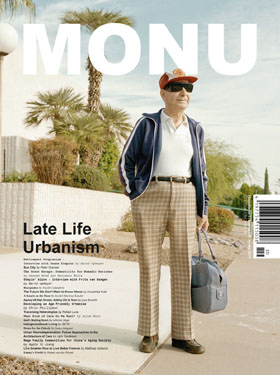






Order a
copy of MONU #30 here.
(browse
the entire issue #30 on Youtube)
Retirement
Utopianism - Interview with Deane Simpson by
Bernd Upmeyer;
Sun City by
Peter Granser;
The Great Escape: Domesticity for Nomadic Retirees by
Hannah Wood and Benjamin Wells;
Stayin'
Alive - Interview with Frits van Dongen by
Bernd Upmeyer;
Bucephalus by
Nicolò Calandrini;
The Future We Don't Want to Know About by
Anuschka Kutz;
A Knock on the Door by
Rachel Marlene Kauder;
Ageing UK High Streets: Adding Life to Years by
Luca Brunelli;
Developing an Age-friendly Urbanism by
Chris Phillipson;
Traversing Heterotopias by
Rafael Luna;
What Kind of Care Do We Want? by
Arjen Born;
God's Waiting Room by
Julienne Gage;
Intergenerational Living by
BETA;
Home for the Elderly by
Junya Ishigami;
Urban Neurodegeneration: Future Approaches to the Architecture of Care by
Jack Sardeson;
Mega Family Communities for China's Aging Society by
Apple Yi Jiang;
Live Smarter Now to Live Better Forever by
Matthias Hollwich;
Emmy's World by
Hanne van der Woude
When
debating how architecture and cities will be impacted in the future by societies
that become increasingly older due to declining fertility rates and rising life
expectancy, a topic that we call "Late Life Urbanism", we have
to consider the so-called "Young-Old", a new social group that emerged
after the mid-point of the twentieth century, as one of the driving forces of
the future, as Deane Simpson explains in an interview entitled
"Retirement Utopianism". To him this social group is so important
because the lifestyles of the people in this group - liberated from the responsibilities
of work and childcare, liberated from the responsibilities of childhood, which
involves education and socialization into society, and at the same time largely
free from rapid physical and mental decline - correspond to a shift from an
ethos of care to one of leisure and entertainment, producing new forms of architecture
and urbanism. What such new forms can look like is depicted by the photographer
Peter Granser in his photo-essay "Sun City"
that portrays one of America's oldest and largest retirement communities in
Arizona, where people are supposed to live an "active new way of life"
instead of simply hanging up the briefcase and waiting to pass away. To what
extent the growing network of young-olds are rejecting an 'aging in place',
and a sedentary and formalized retirement, in favour of a life on the move,
whether with recreational vehicles, cruise ships, or with the help of online
home-rental platforms such as Airbnb, is explained by Hannah Wood
and Benjamin Wells in their contribution "The Great Escape:
Mobile Domesticity for Nomadic Retirees", in which they describe those
retirees as pioneering and adventurous nomads. That people want to remain active
and go on for as long as possible is argued by Frits van Dongen,
the former Chief Government Architect of the Netherlands, who, after more than
thirty years of experience and being in his early 70s, just recently opened
a new office that he describes on his website as a "young Amsterdam-based
office", in another interview called "Stayin' Alive".
Of course, we all wish to live long lives, Anuschka Kutz agrees
in her piece "The Future We Don't Want to Know About". But
she points out that by creating categories such as the "Young-Old"
or the "Third Age" - a period of largely comfortable and often 'successful'
ageing - in which we are more or less fit to carry on with our lives as before
- the 'fun phase of ageing' of 'never-ending holidays' - we have automatically
generated a 'scary room' for those of high age, the "Old-Old" or the
"Fourth Age", and for those who are prematurely incapacitated or frail
and who suffer disability, bereavement, loneliness, and cognitive decline. To
prepare our cities for the old-old, to create an age-friendly urbanism and re-shape
urban society in ways that acknowledge the changes associated with ageing populations,
the gerontologist Chris Phillipson suggests a range of interventions
that he details in his article "Developing an Age-friendly Urbanism:
Re-thinking the City for an Ageing Society". He urges us to re-think
the way we both live and manage our urban environments and raises the following
questions: do older people have a 'right' to a share of urban space? How
can the resources of the city be best used to benefit the lives of older people?
Is the idea of 'age-friendly' caring communities compatible with modern urbanisation?
Furthermore, he emphasizes the importance of ensuring spatial justice for older
people as a crucial part of the debate and to develop an integrated approach
to demographic and urban change as a key task for research and public policy.
According to Rafael Luna, technology will play a crucial role
in improving the lives of older people in the future, referring to the case
of the city of Seoul in South Korea. In his piece "Traversing Heterotopias"
he points out that the future elderly will be a tech-savvy generation that,
although it is impossible to estimate the complexities of future technologies,
has already lived through the third industrial revolution of information technologies
and is advancing the fourth revolution of mass customization, and artificial
intelligence that gives rise to a cybernetic heterotopia for the elderly. Arjen
Born provides with his photos in his contribution "What Kind
of Care Do We Want?" some clues about what such a future - in which
health care robots assist in the care for the elderly - might look like. However,
the human touch and communal ways of life with a strong sense of camaraderie
will remain relevant too when it comes to "Late Life Urbanism"
as Julienne Gage argues in her article "God's Waiting
Room", in which she introduces the case of Miami Beach, where handymen
are resolving issues for old Cuban ladies, doing much more than unplugging their
toilets or cleaning their windows. This is especially true for people with illnesses
such as dementia who ideally live in an environment that is easy to distinguish,
recognize, and remember. In order to produce such an environment Junya
Ishigami, in his project "Home for the Elderly", extracted
sections from wood-frame houses that are scheduled for demolition in various
locations throughout Japan, transported them on trucks without dismantling them,
and connected these into one new architectural structure to build a facility
specifically for elderly people with dementia. That the role of design can indeed
be at the vanguard, creating the right environment and the right support, is
demonstrated by Matthias Hollwich in his piece "Live Smarter
Now to Live Better Forever". If all of this is achieved, people do
not need, despite their age, to lose their love of life and freedom and can
maintain the zest for life and creativity in old age, as Hanne van der
Woude displays beautifully in her series of photographs on "Emmy's
World".
Bernd
Upmeyer, Editor-in-Chief, April 2019
(Cover:
Image is part of Peter Granser’s contribution “Sun City”
on page 14. ©Peter Granser/ from the book Sun City, published by Benteli)
This
issue is supported by Incognita’s
Architecture Trips: Discover Eastern European Architecture and Urbanism.
Find out more about MONU's supporters in Support.
15-10-18 // MONU #29 - NARRATIVE
URBANISM
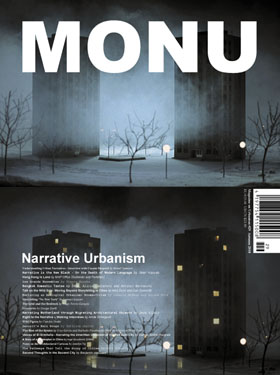






Order a copy of MONU #29 here.
(browse
the entire issue #29 on Youtube)
Understanding
Urban Narratives - Interview with Cassim Shepard by
Bernd Upmeyer; Narrative is the New Black - On the Death of Modern
Language by Omar Kassab; Hong Kong Is Land by MAP Office
(Gutierrez and Portefaix); Les Grands Ensembles by Pierre Huyghe;
Bangkok Domestic Tastes by INDA, Alicia Lazzaroni and Antonio Bernacchi;
Talk on the Wild Side: Moving Beyond Storytelling in Cities by Nick Dunn
and Dan Dubowitz; Narrating an Analogical Urbanism: Rooms+Cities
by Cameron McEwan and Lorens Holm; Storytelling “No New York”
by Lorenzo Lazzari; The Grid and the Bedrock by Tiago Torres-Campos;
Geostories by Design Earth; Narrating Motherland through Migrating
Architectural Objects by Seda Yildiz; Right to the Narrative –
Walking Interviews by Amila Širbegovic; Wild Pigeon by
Carolyn Drake; Detroit’s Nain Rouge by Kathleen Gmyrek;
The Rise of the Kynics by Cruz Garcia and Nathalie Frankowski (WAI Architecture
Think Tank); Voices of El Ermitaño - Narrating the Unwritten Urbanism
of the Self-built City by Kathrin Golda-Pongratz; A Story of a
Masterplan in China by Inge Goudsmit (OMA); Notes on the Architectural
Cartoon by Amelyn Ng; The Pathways That Tell the Story of Cities
by Phil Roberts; Second Thoughts in the Second City by Benjamin
van Loon
To create a better general culture of understanding around architecture,
urban design and urban development issues, we need to use all of the narrative
tools that we have at our disposal, claims Cassim Shepard in the
interview we did with him entitled "Understanding Urban Narratives:
What Cannot be Measured" for this new issue of MONU, "Narrative
Urbanism". Being a filmmaker, he points out that moving images in this
day and age are particularly effective forms of communication as they have the
capacity to make people want to engage. For him, filmmaking is a very useful
process that taught him how to talk to people, how to listen to people, how
to observe spaces critically and with an open mind, in order to understand the
unique urban dynamics that make every space special and worthy of care. Without
that extra attention many things in our cities can simply be forgotten. With
his contribution "Les Grands Ensembles" - a video still of
a film depicting model replicas of two modernist high rise buildings in a barren
nocturnal landscape in the suburbs of Paris - the French artist Pierre
Huyghe attempts to fight such urban amnesia by representing a period
that has remained marginalized and overlooked. In order to bring forth latent
stories and revelations of places and to contribute to the poetics of future
city making through narratives that are often overlooked or excluded, Nick
Dunn and Dan Dubowitz suggest in their article "Talk
on the Wild Side: Moving Beyond Storytelling in Cities" collective
walks through lost parts of cities. In that way one important aspect of Narrative
Urbanism can be understood as the effort to make the invisible visible and
as a discourse concerning the 'common' of the community, as Lorenzo Lazzari
emphasizes in his piece "Storytelling "No New York"",
depicting narratives as complex operations, and the result of the union of several
parts, that require the consideration of diverse aspects of cities. Following
Amila Širbegovic in her contribution "Right to the
Narrative", Narrative Urbanism thus has the potential to make
on the one hand observable the stories of the unheard and the unseen, and on
the other hand to create the possibility for architects, urban designers, and
city planners to participate in - but also to question and to transform - the
conditions of urban sites into which they intervene in their future practice.
How to observe the stories of the people and involve them into creative processes,
is demonstrated by the American photographer Carolyn Drake in
her photo-essay "Wild Pigeon", for which she traveled through
the Xinjiang Uyghur Autonomous Region in China, around 3.000 km from Beijing,
with a box of prints, a pair of scissors, coloured pencils, and a sketchbook,
asking willing collaborators to draw on, reassemble, and use their own tools
on her photographs. And once non-experts are involved in creative processes
and the shaping of cities, the urban dynamics can change, which leads - according
to Kathleen Gmyrek - to participatory narratives, as she argues
in her piece "Detroit's Nain Rouge", in which she explains
how a myth around a red dwarf known as the Nain Rouge, that inspired a parade
in the city of Detroit, offers a public forum for participants to grapple with
the political and socioeconomic forces that are shaping the city's future, providing
the opportunity to play an active role in framing the narrative of their city.
However, since architects are great storytellers too, as Inge Goudsmit
from the Office for Metropolitan Architecture (OMA) reminds us
in her contribution "A Story of a Masterplan in China", they
will remain - together with everybody else involved in the creation of cities
- obliged to make themselves understood better, using the power of "narratives"
to help them to connect not only to experts and intellectuals in the field,
but to everybody else too. But as Cassim Shepard clarifies, such
"expert" narratives should not merely be used to get communities to
agree to new urban developments. What he believes is more important, is to try
to bring narrative strategies into the way we understand the complexity of a
site from the very beginning, and then throughout the project analyze and interpret
and develop what the project is about. For, as Benjamin van Loon
points out in his article on the city of Chicago entitled "Second Thoughts
in the Second City", only through honest storytelling can design make
a difference, because if it weren't for storytelling, would cities exist at
all?
Bernd Upmeyer, Editor-in-Chief, October 2018
(Cover:
Image is part of Pierre Huyghe’s contribution “Les Grands
Ensembles” on page 25. ©Marian Goodman Gallery Paris/New York)
This
issue is supported by Estonian
Academy of Arts’ MA Programme and Incognita’s
Architecture Trips: Discover Eastern European Architecture and Urbanism.
Find out more about MONU's supporters in Support.
16-04-18
// MONU #28 - CLIENT-SHAPED
URBANISM
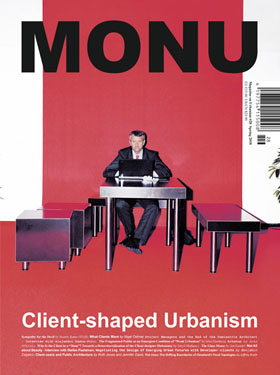






Order a copy of MONU #28 here.
(browse
the entire issue #28 on Youtube)
Sympathy for the Devil by Beatriz Ramo (STAR); What Clients
Want by Nigel Ostime; The
End of the Dominatrix Architect - Interview with Alejandro Zaera-Polo by
Bernd Upmeyer and Beatriz Ramo; Expectation and Reality by
Leewardists; The Fragmented Public as an Emergent Condition of "Weak
Urbanism" by Iulia Hurducas; Arkanum by Aras Gökten;
The King As Client by Azadeh Zaferani; Arterial: The Persistence
of Flow - After the City, This (Is How We Live) by Tom Marble;
Who Is the Client in a "Slum"? Towards a Deterritorialization of the
Client-designer Dichotomy by Tanzil Shafique; Makerspaces: Public
as Client by Nate Bicak; The Clients They Are a-Changing by
Tommaso Raimondi and Paolo Romanò; Behind the Scenes: A Conversation
with my Client by Djamel Aït-Aïssa and Beatriz Ramo (STAR);
The Glass House by Jon Kandel; Not
All about Beauty - Interview with Stefan Paeleman by
Bernd Upmeyer; Negotiating the Design of Emerging Urban Futures with
Developer-clients by Benjamin Zagami; Client-users and Public
Architecture by Ruth Jones and Jennifer Davis; Architecture After
the Client by Nicholas Pajerski; Ariadne's Thread - Diverging
Trajectories of Architect, Client and User by GruppoTorto; Contested
Grounds by Nicole Lambrou; Flat Lines: The Shifting Boundaries
of Cleveland's Fiscal Topologies by Jeffrey Kruth
"Are architects at risk of losing their relevance to the client?"
asks Beatriz Ramo in her contribution "Sympathy for the
Devil" for MONU's issue #28 that we devote to the topic
of "Client-shaped Urbanism". We consider "clients"
to be crucial participants in the shaping and creating of urban spaces. We intend
to find out how to improve things, such as the collaboration between client
and architect or urban designer, for a more satisfying outcome for everybody
involved and above all for the users and inhabitants of cities. For Alejandro
Zaera-Polo architects today have not only lost the trust of clients,
but also the trust of society to deliver anything culturally significant, because
they have been fooling around with idiotic, self-involved ideas for too long
and are now viewed with some level of distrust, as he claims in our interview
entitled "Project Managers and the End of the Dominatrix Architect".
But he partly blames the clients too for this situation. On the one hand, clients
were called in, especially during the 1990s and before the financial crisis
of 2008, to do something weird and shocking that would "put the place on
the map"; on the other, they increasingly started to hand projects over
to project managers, who often took pride in belittling the architect to show
the client that they have everybody under their boot, that they are saving money,
or that they are tough with deadlines, which is, according to Zaera-Polo,
often to the project's loss. To what extent the public can be put down too,
and even excluded from city creation processes, is demonstrated by Iulia
Hurducas in her piece "The Fragmented Public as an Emergent
Condition of "Weak Urbanism"", in which she describes how
the client of every urbanism project appears as a ghostly presence, referring
to processes in the city of Cluj, Romania. Aras Gökten seems
to capture such ghostly presences in his photo-essay "Arkanum".
Money is certainly a very important aspect when it comes to "Client-shaped
Urbanism" as Tanzil Shafique emphasizes in his article
"Who Is the Client in a "Slum"? Towards a Deterritorialization
of the Client-designer Dichotomy", revealing how architects are dependent
on clients - and bound to clients - predominantly for financial reasons. Thus,
if one were to rewrite "Moneytalks", the AC/DC smash hit from the
90's, it would be called "moneybuilds". However, he points out as
well that the role of the client as the patron of 'great works of art and architecture'
is implicit and 'an a priori' in architectural practice, and that urbanism has
been shaped by clients for a long time. Nevertheless, that things can get complicated
leading easily to a tense dynamic between client and architect is dramatically
displayed in Jon Kandel's photo series about the play "The
Glass House" at the Clurman Theatre in New York City, that portrays
the particular problematic relationship between Ludwig Mies van der Rohe and
Edith Farnsworth, who became his client, acolyte, lover, collaborator, frustrated
client, spurned lover, and bitter enemy all within a few years. To avoid frustration
the Belgian real estate developer Stefan Paeleman stresses that
it is of the utmost importance that the client and the architect are on the
same team, respecting each other, and working in the same direction to achieve
a common goal, as he explains in our second interview called "Not All
about Beauty". How architects and urban designers might establish more
trust and initiate more constructive partnerships with their clients is an issue
discussed by Benjamin Zagami in his contribution "Negotiating
the Design of Emerging Urban Futures with Developer-clients": by embracing
a co-creation process, escalating the conventional client-practitioner dynamic
by enabling clients to become active participants and co-designers. According
to Ruth Jones and Jennifer Davis the future users
are ideally the clients of projects as they explain in their piece "Client-users
and Public Architecture: A Look at the Approaches of French Architect Patrick
Bouchain and the French Architectural Collective Exyzt", imagining
a collaborative engagement of the public in the creation of architecture while
making, and funding, architecture conceived as active sites for the collective
construction of citizenship. For whom this sounds too utopian Jeffrey
Kruth suggests - since the client-architect relationship has shifted
from one of patronage to a broader system of data-driven management practices
- that architects re-shape their role into one of dexterity that can consistently
be placed in a position of agency to help re-shape the environment in societally
beneficial ways, as he points out in his text "Flat Lines: The Shifting
Boundaries of Cleveland's Fiscal Topologies". That could lead to new
forms of analysis, representation and experimentation, in practice providing
agency for designers and planners, that better shape the space in which architectural
practice occurs.
Bernd Upmeyer, Editor-in-Chief, April 2018
This
issue is supported by Bauhaus
University Weimar’s International Master Course, Birkhäuser‘s
Vienna – Then and Now, Estonian
Academy of Arts’ MA Programme,
Sotine’s Handmade Jewellery,
Incognita’s
Architecture Trips: Discover Eastern European Architecture and Urbanism.
Find out more about MONU's supporters in Support.
(Cover:
Image is courtesy of Aras Gökten. The image is part of his contribution
"Arkanum" on page 34. ©Aras Gökten)
16-10-17 // MONU #27 - SMALL
URBANISM
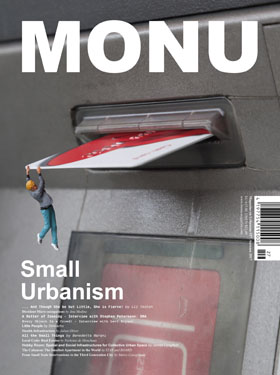






Order a copy of MONU #27 here.
(browse
the entire issue #27 on Youtube)
... And Though She be but Little, She is Fierce! by Liz Teston; Build:
Losing their Identity by Colin Davies; Dissident Micro-occupations
by Ana Medina; Gang Urbanism: Subaltern Bodies Inhabiting Suburbia
by Victor Cano Ciborro; A
Matter of Zooming - Interview with Stephan Petermann/ OMA
by Bernd Upmeyer; Stools as Tools: Tactical Units and Ways of
Sitting in Public Space by Avsar Gürpinar and Nur Horsanali;
Every Object Is a Crowd! - Interview
with Levi Bryant by Bernd Upmeyer;
On Triangles in Squares and the Color of Air by Kyle Miller; Raptures
by Masha Hupalo; Small Scale Practice by Hester van Gent;
Little People by Slinkachu; Stealth Infrastructure by
Julian Oliver; All the Small Things by Benedetta Marani; Local
Code: Real Estates by Nicholas de Monchaux; Hobby Room: Spatial
and Social Infrastructures for Collective Urban Space by James Longfield;
The Cabanon: The Smallest Apartment in the World by STAR and BOARD;
The Apartheid that Can't Be Flushed Away by Nadine Botha; Seeding
the City in Ulaanbaatar's Ger Districts: Urbanisation from the Inside-out
by Joshua Bolchover; Small Urbanism for Refugees by Fabiano
Micocci; From Small Scale Interventions to the Third Generation City
by Marco Casagrande
"… And Though She be but Little, She is Fierce!", the
title of Liz Teston's contribution using a quote from Shakespeare's
"A Midsummer Night's Dream", captures the content of this MONU
issue on "Small Urbanism" very well. For when it comes to urbanism,
small things seem to matter, whether they are actions, small physical elements,
information and communications technology, or small-scale interventions. With
regard to actions, Teston shows how transient micro-urbanisms of protest
architecture can have a significant impact on our cities. During such actions,
human bodies can alter public spaces through practices that challenge the arrangement
of urban power and convert it into a channel of opposition, as Ana Medina
argues in her piece "Dissident Micro-occupations".
In her explorations of dissident architectural practices, she reveals that spaces
for protests are in fact not designed, but taken over by the dissidents to transform
the architectural urban landscape. However, the design of physical elements
- and especially small physical elements - appears to be very relevant for "Small
Urbanism", as architecture and urbanism seem to remain the key interface
of the physical manifestations of our society. Every architectural element,
whether big or small, seems to have an urban consequence, as Stephan Petermann
from the Office for Metropolitan Architecture (OMA) puts it in
our interview with him entitled "A Matter of Zooming". How
we design things can make a real difference in our lives, both socially and
politically, and we should be attentive to that, claims the philosopher Levi
Bryant in another interview that we titled "Every Object is
a Crowd!". According to him, objects exist, within the framework of
object-oriented ontology, at a variety of different levels of scale and all
objects are composites of other objects. Additionally, there is a gravity of
things and a power of materiality that makes all sorts of profound differences
in the world and in cities. With his miniature people, the artist Slinkachu
aims to make visible these differences that small things can make, which can
easily be overlooked and ignored. He achieves this intriguingly in his contribution
"Little People". That small but important objects in our cities
can easily go unnoticed, because they are sometimes hidden on purpose, especially
when it comes to information and communications technology and in particular
to cellular infrastructure that is necessary for mobile phone networks, is revealed
by Julian Oliver in his piece on "Stealth Infrastructure".
By exposing our cities' less visible infrastructure he aims to remind us of
our dependence on a deeper physical reality - and our consequent implicit vulnerability
- and that our cities are engineered and technical places as much as they are
natural expressions of the Human and the Social. To what extent small information
and communications technology tools and devices can be used for the renewal
of entire neighbourhoods and the fight against criminality in cities, is demonstrated
by Benedetta Marani in her article "All the Small Things".
And since information and information technology is growing rapidly, as Nicholas
de Monchaux puts it in his contribution "Local Code: Real Estates",
where he points out that information is increasingly spatial, and, more than
ever, urban in its origins and character, there is good news for the future
of our cities. It turns out that "Small Urbanism" is most powerful
when it is used as an urban renewal and redevelopment strategy, above all in
the form of small-scale interventions. How such strategies can work is shown
by James Longfield in his piece "Hobby Room: Spatial and
Social Infrastructures for Collective Urban Space", where a series
of small hobby rooms, designed for residents to pursue activities either individually
or in groups, is inconspicuously knitted into the grain of the housing, as a
new site for civic engagement and for the retention of the social ties of a
close-knit working class community. Small-scale interventions can also be used
as a design methodology on the urban fabric aiming at ripple effects and transformation
of the larger urban organism, as Marco Casagrande proposes in
his article "From Small Scale Interventions to the Third Generation
City". Through his project in the city of Taipei he demonstrates how
such interventions, while being in touch with site-specific local knowledge,
are able successfully to produce small-scale, but ecologically and socially
catalytic developments on the built human environment.
Bernd
Upmeyer, Editor-in-Chief, October 2017
This
issue is supported by University
of Leuven’s Master of Human Settlements and Master of Urbanism and Strategic
Planning, Stadslab’s
Masterclasses: “Darling Intercultural Space” and “Shenzhen Urban
Villages”, Rotterdam’s
Het Nieuwe Instituut: Exhibition “The Other Architect”, Stroom
Den Haag: Exhibition “Céline Condorelli” - Proposals For A
Qualitative Society (Spinning), Incognita’s
Architecture Trips: Discover Eastern European Architecture and Urbanism.
Find out more about MONU's supporters in Support.
(Cover: Image is courtesy of Slinkachu. The image is part of his contribution
"Little People" on page 65. ©Slinkachu)
18-04-17 // MONU #26 - DECENTRALISED
URBANISM
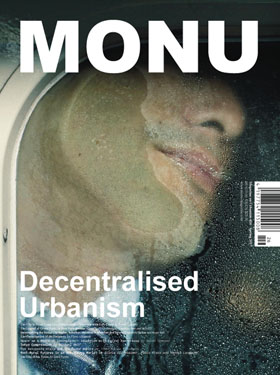






Order a copy of MONU #26 here.
(browse
the entire issue #26 on Youtube)
The City Is Dead! Long Live Urbanization…
Interview with Lars Lerup by Bernd Upmeyer;
Decentralized Consumerism by David Karle and Caitlin Tangeman;
Texas Unbound by Ian Caine; The Legend of Grand Paris,
or How Paris Became Great by STAR strategies + architecture and BOARD;
Decentralizing the Global City Region: Suburban Identities in Frankfurt and
Toronto? by Bernd Belina and Roger Keil; The Road City and the
Rurban Potentials by Mario Matamoros Rosales; The Emancipation
of the Periphery by Floris Alkemade; The Segmented Metropolis
by Carlo Pisano; The 'Divine' Struggle of Building Utopias by
Yannis Tzaninis; Opposing Oppositions, All City/All Land by Maarten
Gheysen, Kris Scheerlinck and Erik Van Daele; Space
as a Media of Innovation - Interview with Keller Easterling by
Bernd Upmeyer; The Edge City is Dead by Judith K. De
Jong; Tokyo Compression by Michael Wolf; Current Obstacles
and Future Possibilities in Post-war Residential Suburbs of Tokyo by
Rugile Ropolaite; Cities within the City, Density in the Territory: Public
Housing Estates and the Transformation of Hong Kong by Ivan Valin and
Natalia Echeverri; The Autoroute State and the Geeks Empire by
Constantina Theodorou; Decentralised Suburbanism or Suburban Conditions
of Living around Athens by Alexandros Zomas and Mara Papavasileiou; Post-Rural
Futures in an Urbanising World? by Bianca Elzenbaumer, Fabio Franz and
Hannes Langguth; The City of Six Towns by Mark Power
Centrality is dead. Lars Lerup does not hold back in an interview
with us entitled "The City Is Dead! Long Live Urbanization…".
In this new issue of MONU we discuss what centrality means for cities
today and explore and assess cities that are organized in a decentralized or
polycentric way - something we call "Decentralised Urbanism"
- in general and as a strategy to plan the growth of cities and their metropolitan
areas. Thus, to a certain extent, we continue the discussion of MONU #19,
entitled "Greater Urbanism", on how metropolitan areas of cities
should be organized in terms of governance, politics, space, architecture, sociology,
ecology, and economics, but now with a focus on "Decentralised Urbanism".
According to Lerup we eventually should be able to understand
urbanization as a vibrant kind of fast and slow moving apparatus, and in a way
as a virus that reproduces itself at the same time. But we should see urbanization
also as a surface that is not really a surface but a thickness and a force field
in which you carry the centre with you. Why a city sometimes has to die to save
its periphery and allow urbanization and not centrality prevail is perceptively
demonstrated by STAR strategies + architecture and BOARD
in its contribution "The Legend of Grand Paris, or How Paris
Became Great" in which "Paris had to be killed to save its homeland".
Bernd Belina and Roger Keil in their piece "Decentralizing
the Global City Region: Suburban Identities in Frankfurt and Toronto?"
explain that peripheral places already actively position themselves as players
in the area and even as global cities. They argue that these individual regional
municipalities essentially practice a form of decentralized urbanism in a centralized
world of global urbanization. Nevertheless, Floris Alkemade complains
that the general public and developers still tend to assign a lesser status
to the periphery reserving their attention and appreciation for the city centres,
which has led to a structural underestimation of, and lack of commitment to,
our peripheral areas, as he points out in his article "The Emancipation
of the Periphery". He considers the periphery as a prime location for
radical modernization and an arena for innovation that has the potential, especially
with the help of self-driving cars, to deliver particularly attractive residential
areas. However, Keller Easterling believes that automated vehicles,
although currently discussed frequently in relation to "Decentralised
Urbanism" and as the saviour of all problems of movement and infrastructure,
may also create more congestion, emissions, and sprawl if people use those vehicles
instead of transit, as she states in an interview with us called "Space
as a Media of Innovation". Therefore, she advocates inserting the idea
of the "Switch" that allows passengers to up-shift and down-shift
into transportation of different capacities. Transportation and commuting are
obviously crucial aspects of "Decentralised Urbanism". How
tough commuting within metropolises and metropolitan areas can be is quite impressively
shown in Michael Wolf's contribution "Tokyo Compression".
But since the expanding global urbanization process comes with an ever-growing
amount of commuting, as Constantina Theodorou emphasizes in her
piece "The Autoroute State and the Geeks Empire", it becomes
ever more necessary that answers to the problem of the rising nomadic population
- whether refugees, commuters, or constantly moving freelancers, who are not
citizens of the places they inhabit - are found. To solve this problem of "Decentralised
Urbanism" she proposes a new and loosened relationship of power to
territory so that other forms of sovereignty can emerge such as the social sovereignty
practiced by actors other than the state and detached from a certain territory.
Examples of such actors in an increasingly urbanising world are decentralised
community economies leading to a decentralised community-oriented urbanism that
Bianca Elzenbaumer, Fabio Franz, and Hannes
Langguth discovered in future-oriented post-rural alpine regions, as
they call them in their article "Post-Rural Futures in an Urbanising
World?". And since in the final analysis the functioning of "Decentralised
Urbanism" will be largely dependent on the people and their communities,
it is quite fitting that Mark Power portrays the polycentric city
of Stoke-on-Trent and its inhabitants in his photo essay "The City of
Six Towns".
Bernd Upmeyer, Editor-in-Chief, April 2017
This
issue is supported by University
of Leuven’s Master of Human Settlements and Master of Urbanism and Strategic
Planning, KotorAPSS’
Architecture Prison Summer School, University
of Liechtenstein’s Master (MSc) of Architecture, Erasmus
University Rotterdam’s Institute for Housing and Urban Development Studies
(Ihs), Incognita’s
Architecture Trips: Discover Eastern European Architecture and Urbanism,
The Estonian
Academy of Arts’ Urban Studies MA Programme, Stadslab’s
Masterclass: Tbilisi Courtyards. Find out more about MONU's supporters in
Support.
(Cover:
Image is courtesy of Michael Wolf. The image is part of his contribution
“Tokyo Compression” on page 81. ©Michael Wolf)
17-10-16 // MONU #25 - INDEPENDENT
URBANISM
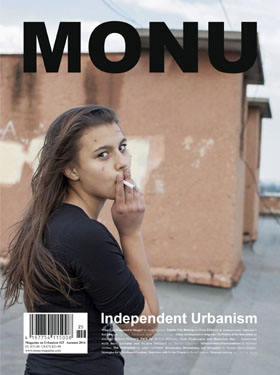






Order a copy of MONU #25 here.
(browse
the entire issue #25 on Youtube)
What Ever Happened to Skopje? by Jasna Mariotti; Capital
City-Making by Gruia Badescu; A Translocal Capital? Prishtina
by Kai Vöckler and Jonas König; Urban Development in
Belgrade: The Politics of the New Urban by Alexander Kleibrink; Victory
Park by Arnis Balcus; On the Condition of Post-(communist) Urbanism
and Urban Public Squares in Lithuania by Tomas Grunskis; …Of
the New Now by Milda Paceviciute and Burak Pak; Pink
Flamingos and Muscular Men - Interview with Bart Lootsma and Dijana Vucinic
by Bernd Upmeyer; The Project
of the Post-industrial Landscape of Solana Ulcinj by Marco Scarpinato
and Lucia Pierro; Infrastructure of Independence by Martynas Mankus;
Forming Identity Across Boundaries by Thomas Cole; The
Unfinished by Julien Lombardi; Terror and the Miracle - Taiwanese
Dreams by Florence Twu; Decentralize, Desecularize, and Deregulate
by Suzanne Harris-Brandts; Enclaves of Independence by
Joseph Godlewski; The Taxi Rank and the Mega Mall by Claire
Lubell; Strategies for a Newfound
Freedom - Interview with Gvido Princis by
Bernd Upmeyer; The Potential of Weak Urbanism by Sandra
Parvu; Transnistria by Julia Autz
A city in a country that recently gained independence is likely to undergo
processes of radical transformation and massive restructuring and re-imagining
that are not only societal, political, and economic in nature, but can also
impact the planning system of a city and influence its built-up environment.
Jasna Mariotti makes this quite clear in her contribution to
MONU, entitled "What Ever Happened to Skopje?". This new
issue of our magazine deals with various phenomena impacting cities of countries
that became newly independent which we call "Independent
Urbanism". She shows how the centre of Skopje in Macedonia has been
remodeled according to an image of the city that never existed as such. Obviously,
many "independent" cities are facing major struggles
and difficulties in finding their new identity that usually have a lot to do
with the fact that the "birth of a country" is a contested
process often involving political turmoil, institutional instability, and economic
turbulence as Kai Vöckler and Jonas König
put it in their article "A Translocal Capital? Prishtina".
The way monuments and public spaces that are loaded with a "dependent"
past can add controversial issues, collective and personal contradictions, and
traumas to this process is illustrated by Arnis Balcus in his
photo essay "Victory Park". According to Dijana Vucinic,
preserving identity within the cities and cultures that are heading towards
the EU is one of the biggest challenges for a country such as Montenegro and
for other countries that went through very significant transformations after
the era of socialism, as she stated in an interview with her and Bart
Lootsma entitled "Pink Flamingos and Muscular Men - Independence
is a Relative Phenomenon". To what extent urban and public infrastructure
can help here as an important element of nation building and even be instrumentalized
to instigate, stimulate, and secure the growth of cities, is explained by Martynas
Mankus in his text on "Infrastructure of Independence".
Whether so-called "Free Industrial Zones" can be successful strategies
for "independent" cities to thrive is discussed by Suzanne
Harris-Brandts in her contribution "Decentralize, Desecularize,
and Deregulate" in which she highlights the situation and transformation
of the city of Kutaisi in Georgia. There seems to be no doubt that an opening
up to independent views, different approaches to urbanism, and a building up
of international networks are crucial steps for the successful development of
"independent" cities. At least this is what Gvido
Princis, the director of the Riga City Architect's Office, argues when
he reflects on his experience in the city of Riga in Latvia, in our second interview
entitled "Strategies for a Newfound Freedom". Only then "independent"
cities might get a chance to develop in a way that enables them to fulfil
the dreams of a more colourful and more hopeful world especially for the younger
generation, as Julia Autz emphasizes with her photo series "Transnistria".
Bernd Upmeyer, Editor-in-Chief, October 2016
This
issue is supported by University
of Leuven’s Master of Human Settlements and Master of Urbanism and Strategic
Planning, Estonian
Academy of Arts’ Interdisciplinary Master’s Programme in Urban Studies,
Erasmus
University Rotterdam’s Institute for Housing and Urban Development Studies
(IHS) and Incognita's
Architectural Study Tours. Find out more about MONU's supporters in Support.
(Cover:
Image is courtesy of Julia Autz. The image is part of her contribution
“Transnistria” on
page 121. ©Julia Autz)
18-04-16 // MONU #24 - DOMESTIC
URBANISM
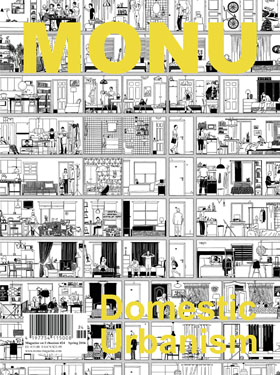






Order a copy of MONU #24 here.
(browse
the entire issue #24 on Youtube)
The Home as Political Arena - Interview with Andrés Jaque by Bernd
Upmeyer; Chantal Akerman, Yasujiro Ozu, and the Poetics of Intimate Space
by Sander Hölsgens; The Fridge, the City and the Critique
of Everyday Life by Justinien Tribillon; How to Domesticate a
City: Adaptive Tools to an Urban Environment by CENTRALA (Simone De Iacobis,
Malgorzata Kuciewicz), with Aleksandra Kedziorek; The Minor Composition
of Threshold Domesticities by Lucía Jalón Oyarzun;
Redefining the Domestic between New Forms of Dwelling and Emerging Social Problems
by Luca Lazzarini; The Pavilion by åyr; Re-Addressing
Commons by Fabrizia Berlingieri; Housing in Continuity by
Aron Bohmann and Charlotte Herbst; A Nice Normal Little Village by
Cookies; An Amalgamation of Homes: 3 Micro-stories by Nele Aernouts
and Sofie Van der Linden; Domestic Insecurities by Ersela Kripa
and Stephen Mueller (AGENCY); The Circulation of Domesticity in a New
Political Economy by Ioanna Piniara; Urbanism From Within by
Neeraj Bhatia and Christopher Roach; A Short Guide through the Grand
Domestic Revolution by Casco; Socialist Urban Planning and the
Housing Question: At Home in Skopje by Jasna Mariotti; The Interior
of the Metropolis by STAR strategies + architecture; Live, Work,
Play: Learning from the Athfield House and Office by Julia Gatley, Marco
Moro and Simone Ferreli; Domesticity - Interview with Herman Hertzberger
by Bernd Upmeyer
What happens in domestic interiors appears to be very relevant for our societies.
At least, that is what Andrés Jaque argues in our interview
entitled "The Home as Political Arena" for this new issue of
MONU. This issue, "Domestic Urbanism", deals with the
domestic aspects of cities, and everything that is related to the human home
and habitat, the scale of the house, people's own universe, things that are
usually hidden and private. According to Jaque, a great number
of the processes by which our societies are shaped take place in domestic interiors,
the domestic realm, and in relation to very domestic elements such as the table
setting, the Christmas tree, or the TV remote control. Justinien Tribillon
- in his contribution "The Fridge, the City and the Critique of Everyday
Life: a Tale of Domestic Urbanism" - describes, for example, to what
extent a domestic element such as the refrigerator has changed radically the
way we consume the city. Because the domestic infiltrates the urban and, vice
versa, the city leaks into the house, the city needs to be seen as a continuous
fabric of differential intensities rather than a patchwork of enclosed categories
that distinguish between private and public, house and city, or inside and outside.
In her piece "The Minor Composition of Threshold Domesticities"
Lucía Jalón Oyarzun explains how our private domestic
spaces are becoming increasingly more public as demonstrated by åyr,
an art collective that focuses on contemporary forms of domesticity and the
effects of the internet on the city. In their contribution "The Pavilion"
they feature photos of Airbnb apartments that were used as exhibition spaces
during the Venice Biennale of Architecture in 2014. That the internet plays
a growing role in "Domestic Urbanism" is illustrated by the
Rotterdam-based collective Cookies in their article "A
Nice Normal Little Village", showing how the digital machines of today
might articulate our domestic lives tomorrow, based on their research into a
care facility for elderly people on the outskirts of Amsterdam. In this facility
the domestic environment of the patients is reconstructed retroactively, something
which is not so far removed from the simulated domestic environments on military
training sites that Ersela Kripa and Stephen Mueller (AGENCY)
refer to in their piece "Domestic Insecurities". Neeraj
Bhatia and Christopher Roach in their article "Urbanism From
Within" show us how to re-imagine and re-think the domestic and the
house as one of the smallest and most valuable urban units in order to create
new affordable housing units. One solution would be to make use of the many
illegal secondary units that exist within a city, such as hidden garages, attics,
rear yards, or underutilized spaces of homes. That the needs of people and the
relationship of people should to be placed at the centre of all actions while
re-inventing and evolving the concept of the domestic and the home is emphasized
by Casco, an office for art, design, and theory in their contribution
"A Short Guide through the Grand Domestic Revolution" in which
they explore the domestic sphere to imagine new forms of shared living and working.
In order to prepare ourselves for a future that is once again in desperate need
of a revolution in housing, the design of floor plans, and strategies for typologies,
we need to end what STAR strategies + architecture describes as
the "festival of facades". We need to dare remove the cover and observe
with fresh and curious eyes what is happening behind and inside buildings and
adapt the homes and the domestic spaces of people not merely to regulations,
but to the diverse ways of life and especially the changing ways of life of
the inhabitants, accentuating that the true revolution should happen indoors,
as they point out in their piece "The Interior of the Metropolis".
Similarly, in our interview entitled "Domesticity", Herman
Hertzberger underlines the importance of the idea of a small and basic
unit, which provides people the possibility - whether they are rich or poor
- to turn their houses into what they want them to be, with a broad variety
of options. Furthermore, he stresses that architects should stop being too concerned
with aesthetics, but ought to create new paradigms with regard to domestic spaces
rather than just thinking about creating nice forms.
Bernd
Upmeyer, Editor-in-Chief, April 2016
This issue is supported by University
of Leuven’s Master of Human Settlements and Master of Urbanism and Strategic
Planning, Erasmus
University Rotterdam’s Institute for Housing and Urban Development Studies
(IHS), University
of Liechtenstein’s Master (Msc) of Architecture and Incognita's
Architectural Study Tours. Find
out more about MONU's supporters in Support.
(Cover:
Image is courtesy of STAR strategies + architecture. The image is part
of their contribution "The Interior of the Metropolis" on page
106. ©STAR strategies + architecture; Illustrator: Masha Krasnova-Shabaeva)
19-10-15
// MONU #23 - PARTICIPATORY
URBANISM
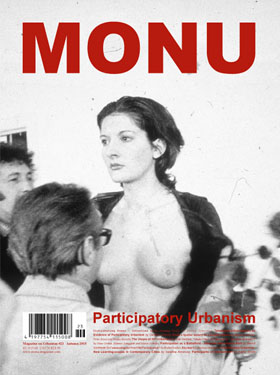






Sold out.
(browse
the entire issue #23 on Youtube)
Distributing
Power - Interview with Jeremy Till by Bernd Upmeyer; Temporary
Urban Spaces as Evidence of Participatory Urbanism by Carolyn Sponza;
Towards a New Urbanism - Emergent Strategies by Gonzalo J
López; Learning from Advocacy Planning by Verena
Lenna; From a Spatial Society to a Spatial Culture by Moana
Heussler, Peter Jenni and Stefan Kurath; The Utopia of DIY Urbanism:
The Case of the Holzmarkt Cooperative, Berlin by Uta Gelbke; "Make
City" in Times of an "Absolute Present"? by Nina Gribat,
Hannes Langguth and Mario Schulze; Participation as a Battlefield
- Interview with Damon Rich by Bernd Upmeyer; Is Commoning
the New/Old Participation? by Stefan Gruber; Commons, Participatory
Urbanism and Democratic Participation by Nele Aernouts and Thomas Decreus;
Participatory Design as Tailoring by Andrea Spreafico; Rhythm
0 by Marina Abramovic; The Interactionist City by Tom Marble;
The Urban Citizens' Extitutional Processes in Madrid by Esaú
Acosta, Mauro Gil-Fournier, Miguel Jaenicke (SIC, VIC); Citizen
Participation in Chilean Urban Micro-Strategies: I love my Neighborhood Program
by Luis Eduardo González; Participatory Urbanism:
New Learning-scapes in Contemporary Cities by Serafina Amoroso; Participation
Time by Sheryl-Ann Simpson What's Wrong With? by
Jaffer Kolb and Anya Sirota; Participants or Consumers? The 'Do
It Yourself' Construction of the Twenty-First Century City by Cathy Smith
In order to avoid participation in architecture and urban design becoming
merely a politically required token of democratic involvement - a kind of fake
participation that does not actually engage the participants in any meaningful
way - architects, planners, and designers need to commit themselves and relinquish
control, as Jeremy Till claims in an interview with us entitled
"Distributing Power". With this new issue of MONU on
the topic of "Participatory Urbanism" we aim to find
out and reassess to what extent individual citizens really can and should become
proactive in the production and development of cities and in the shaping of
neighbourhoods, and where the limits of such Participatory Urbanism
really lie. However, giving up control and power can be tricky, as planning
experts are usually sceptical of participation procedures and tend to consider
such procedures an interference in their competences. Instead, they tend to
reject the possibility of enrichment of urbanist practice through multilayered
urbanistic concepts, as Moana Heussler, Peter Jenni, and Stefan Kurath
argue in their contribution "From a Spatial Society to a Spatial
Culture". This kind of disbelief, according to Damon Rich,
has spawned legions of "public participation consultants" that offer
governments in the US a "bulletproof process" that no amount
of citizen disruption is able to stop, as he told us in an interview entitled
"Participation as a Battlefield". A certain doubt with regard
to the functioning and effectiveness of participation procedures is to a certain
extent understandable, of course, as such processes easily become too complicated
and impossible to manage. Bringing more people at the table certainly does not
make things easier, as so many people are involved in architectural and urban
projects already, even without citizens' participation. That the process might
get complicated and even dangerous when people participate in projects is quite
impressively demonstrated by Marina Abramovic in her art performance
"Rhythm 0", in which she tests the limits of the relationship
between performer and audience and tries to find out how far the public is willing
to go, learning that: "if you leave it up to the audience, they might
kill you." In order to not kill anybody and to organize participatory
design processes in a satisfying way, Serafina Amoroso - in her
piece "Participatory Urbanism: New Learning-scapes in Contemporary Cities"
- points out that architects and urban designers need the knowledge of the user
as expert-citizen through which the process becomes a two-way street and expansive.
After all, knowledge is not just 'content' to be transmitted and learnt, but
demands a deeper understanding in terms of experience and empathy. Only then
can public participation in architecture and urbanism lead to scenarios in which
both professionals and non-professionals alike are enabled to become active
producers, working inside and in between the existing spaces of their host cities
as Cathy Smith states in her article "Participants or
Consumers? The 'Do It Yourself' Construction of the Twenty-First Century City".
And only then projects can flourish that create a sense of social inclusion
and authenticity that cannot be dismissed as little more than 'hipster economics'.
(Bernd Upmeyer, Editor-in-Chief, October 2015)
This issue
is supported by University
of Leuven’s Master of Human Settlements and
Master of Urbanism and Strategic Planning, Bauhaus
University Weimar’s International Master Programmes, Luleå
University of Technology’s Master Of Science in Climate Sensitive Urban
Planning and Building, Fontys’
Masterclass Lisbon 2016, University
of Liechtenstein’s Master (Msc) of Architecture, and Erasmus
University Rotterdam’s Institute of Urban Management (IHS).
Find out more about MONU's
supporters in Support.
(Cover Image: Rhythm
0, performance, from Marina Abramovic’s contribution on page
82. Location: Studio Morra Naples, 1974, Photo: Donatelli Sbarra. ©Marina
Abramovic. Image is courtesy of the Marina Abramovic Archives)
20-04-15
// MONU #22 - TRANSNATIONAL URBANISM
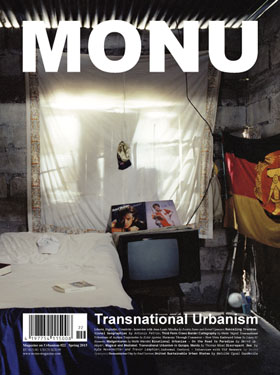






Order a copy of MONU #22 here.
(browse
the entire issue #22 on Youtube)
Liberté,
Digitalité, Créativité - Interview with Jean-Louis Missika
by Beatriz Ramo and Bernd Upmeyer; On Home, in a World of Non-possession
by Merve Bedir; Rescaling Transnational Geographies by Antonio
Petrov; Third Form Cross Border Cartography - A Middle Eastern Exostructure
by Maier Yagod; Transnational Urbanisms of Asylum Trajectories
by Kolar Aparna; Global Towns in the New Copperbelt by Justin
Hui; Harmony Through Commerce - How Yiwu Embraced Islam by Laura
M. Henneke; Madgermanes by Malte Wandel; Binational Urbanism
- On the Road to Paradise by Bernd Upmeyer; Zeeuws Vlaanderen,
NL/BE: The National Border as Catalyst for a Transnational Periphery by
Pepijn Bakker and Rutger Huiberts; Magical and Mediated: Transnational
Urbanism in Quiapo, Manila by Thomas Mical; Hidden Space - Social
Space - The Spatiality of Temporary Migration Between Home and Host Countries
by Dalal Musaed Alsayer; Actor Map of Korea - And Spatial Scenarios
of Transnational Networks by Yehre Suh; Transit Space in The Straits
Megacity Region by Agatino Rizzo; Discrepant Sea by Kyle
Hovenkotter and Trevor Lamphier; The Urban Pier - Exchanges of Work
by Zoé Renaud; Informal Control - Interview with Ulf Hannerz
by Bernd Upmeyer; New Prospects for Urban Planning by Giovanni
Matteo Cudin; Humanitarian City by Paul Currion; United
Sustainable Urban States by Matilde Igual Capdevila
To prepare
our cities for the emergence and growth of transnational lifestyles we need
to invent new urban and architectural forms that are adapted to these new ways
of life. This is what the French sociologist and assistant Mayor of Paris, Jean-Louis
Missika, emphasized in an exclusive interview with MONU entitled
“Liberté, Digitalité, Créativité”
on the topic of “Transnational Urbanism”. This new issue of
MONU focuses on the impact of transnational processes on cities
in general and the consequences of transnational relations between individuals,
groups, firms, or institutions for cities in particular. We deemed it necessary
to dedicate an entire issue to the phenomenon of transnationalism in
relation to the city, to architecture, and its influence on cities in spatial
as well as social, political, economical, and cultural terms, as these days,
more than ever before, and due to the development of technologies that have
made transportation and communication infinitely more accessible and affordable,
people can create and maintain multiple links, networks, and interactions across
the borders of nation-states. In that regard, Missika stressed
furthermore the importance of an open government: open to innovation and to
innovative projects in which a lot of different people have to work together
and citizens participate in planning processes. Only then can transnational
urban landscapes that support transnational urban lifestyles be created as “super
geographies”, as Antonio Petrov puts it in his contribution
“Rescaling Transnational Geographies”, moving architecture
beyond geographical constraints, borders or boundaries and support the flow
of people and information. In such urban landscapes “imagined communities”
without the need for physical or territorial contact and a communal consciousness
can emerge independently - that is: characterized by small everyday gestures,
acts, practices, and exchanges between individuals, as Kolar Aparna
states in her piece “Transnational Urbanisms of Asylum Trajectories”.
Under these conditions transnational places can be created in cities where people
can feel at home no matter where they come from, as Laura M. Henneke
argues in her contribution “Harmony Through Commerce – How Yiwu
Embraced Islam”. Due to globalization urban spaces are emerging that
are witnessing increasing intensity of use, mixed desires and mixed codes, cross-fertilizing
urban sites with an enlarged spectrum of identities as Thomas Mical
argues in his article “Magical and Mediated: Transnational Urbanism
in Quiapo, Manila”. Kyle Hovenkotter and Trevor
Lamphier, in their contribution “Discrepant Sea”, define
the architectural style that appears under such transnational circumstances
as characterized by duplicity, invisibility, and temporality, in contrast to
the technological fetishism, transparency, and material honesty that distinguished
the first international style. Nevertheless, such multiple identities and temporalities,
according to Ulf Hannerz - a pioneer in urban and social anthropology
whose research on culture in the age of globalization suggested as early as
the 1960s the dynamic, flowing, creative, and continuously changing character
of the process - will not necessarily lead to identity problems of urban spaces,
since the diversity of neighbourhoods will take care of this, as he explained
to us in another interview entitled “Informal Control”. While
trying to demystify culture, something he sees as ‘processual’, he
considers human beings to be agents who keep culture going by doing, watching,
listening, and learning. Understanding “Transnational Urbanism” as
an urban culture that needs to remain in motion continuously, reinvent itself
perpetually, in order to sustain itself, might lead to the fulfilment of our
desires and cosmopolitan visions for a better future, and a world without borders,
as Matilde Igual Capdevila dares to dream in her piece “United
Sustainable Urban States”.
(Bernd Upmeyer, Editor-in-Chief, April 2015)
This issue is supported by EMU
- European Post-masters in Urbanism, Bauhaus
University Weimar’s International Master Programmes, Fontys’
Master of Architecture and Master of Urbanism, University
of Liechtenstein’s Master (MSc) of Architecture,
University
of Leuven’s Master of Human Settlements, Erasmus
University Rotterdam’s Institute of Urban Management (IHS),
Incognita’s
Architecture Trips,
and Studio for
Immediate Spaces - Sandberg Instituut, Amsterdam. Find
out more about MONU's supporters in Support.
(Cover Image: “Sleeping room of Nelson Ernesto Monheguete with cooker,
TV and other relics from the former GDR” from Malte Wandel’s contribution
“Madgermanes” on page 52. Photo is ©Malte Wandel.)
20-10-14
// MONU #21 - INTERIOR URBANISM
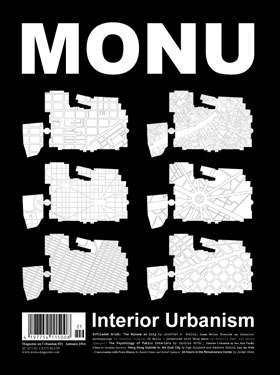






Sold out.
(browse
the entire issue #21 on Youtube)
Enfiladed Grids: The Museum
as City by Jonathan A. Scelsa; Scalar Liaisons: Claiming The Public
Interior by Amin Alsaden; Dark Transparency by Colleen
Tuite; Some Notes Towards an Interior Archipelago by Brendan Cormier;
From Domestic Housh to Consumer Mojama'a: The Social Space of Women in
Kuwait by Dalal Musaed Alsayer; Kinder Egg City by Mireille
Roddier and Keith Mitnick; 3D Nolli - Interview with Winy Maas by
Beatriz Ramo and Bernd Upmeyer; Analogous Spaces: Notes towards a Postal
Interiority by Jesse Vogler; Endless Architecture: Accidental
Manifestos for the Interior by Michael Piper and James Khamsi;
The Psychology of Public Interiors by Candida Höfer; Mind
the Gap:Reading a City through its Subway System by Shriya Malhotra;
Interior Urbanism in two Asia Pacific Cities: Spatial Intensifications in Hong
Kong and Hanoi by Serafina Amoroso; The Development of the Urban
Council Building OR by Christiane Lange and Susanne Trumpf; Hong
Kong: A Sky-less Urbanism by Michelle Xiaohong Ling; Hong Kong
Outside In: the Dual City by Inge Goudsmit and Adrienne Simons; Into
the Wild- Conversation with Petra Blaisse by Beatriz Ramo and Bernd Upmeyer;
Mall Futures by Judith K. De Jong; The Roof is NOT flat
by David Karle; Second City: Chicago's Accessory Urbanism by
Kyle Reynolds; 24 Hours in the Renaissance Center by Jordan Hicks
While our world is progressively
becoming more urban everywhere, a process is on its way that seems to penetrate
increasingly every part of our life and does not appear to stop at the thresholds
of our buildings, but influences interior spaces, in particular public interior
spaces, as much as everything else. According to Jonathan A. Scelsa
this becomes evident in contemporary designs of museums as he argues in his
contribution to this new issue of MONU on the topic of "Interior
Urbanism", that deals with the urban scale and urban aspects of interiors
and especially of public interiors. In his piece "Enfiladed Grids: The
Museum as City" he shows how museums today are being conceived more
and more as interior cities within cities. Museum architecture, for example,
is informed and driven by urban grids. For Brendan Cormier urban
life is an interior affair anyway as we spend ninety percent of our lives indoors.
Thus, the city is a massive aggregation of interior environments; our homes,
our workplaces, the restaurants and bars that we socialize in, our daycare services
and schools, or our doctor's office. In his article entitled "Some Notes
Towards an Interior Archipelago" he imagines a city life that is composed
of a series of different and highly individuated interior islands. Individualization
and especially personalization play an important role as well for Winy
Maas when it comes to interior spaces, as he explains in an interview
with us entitled "3D Nolli", where he stresses the necessity
and importance of generosity, to express yourself, and to be able to influence,
shape, and personalize your environment to ultimately feel welcome and at home
in interiors. In reference to his "Book Mountain" project he
argues that to his mind public libraries are one of the last remaining real
public buildings of our generation. Candida Höfer in her
contribution "The Psychology of Public Interiors" illustrates
the rich and varied interiors of libraries. Winy Maas introduces
the Nolli map into the discussion on urban interiors as a tool to analyze
to what extent public interiors are becoming gradually more urban, although
he acknowledges its limits as it is only two-dimensional and do not tell anything
about heights and facades, for example. As a sort of updated and reloaded hyper-version
of Nolli's map, Serafina Amoroso - in her article "Interior
Urbanism in two Asia Pacific Cities: Spatial Intensifications in Hong Kong and
Hanoi" - portrays the city of Hong Kong. Urban spaces, regardless of
the public or private nature of their stakeholders, form a continuum of collectively
used spaces that link urban routes and new interiors of social life with a particular
atmospheric presence, energizing and activating them. But for Inge Goudsmit
and Adrienne Simons the atmosphere of Hong Kong's indoor spaces
is by far too orchestrated, too private, and too controlled, supporting social
segregation and creating an uncomfortable grey area between public and private
spaces, in which no room for spontaneity or chance encounters remains, as they
point it out in their piece "Hong Kong Outside In: the Dual City".
For Petra Blaisse too, with whom we held a conversation entitled
"Into the Wild", public interior spaces can easily become too
regulated to provide room for chance, surprise, improvisation, and a certain
kind of wilderness. However, she thinks it is possible that such "wilderness"
may be combined with very well-controlled and well-ordered organizations. Under
such conditions public interior spaces can act as dramatizations of urban spaces
- able to celebrate the collective psychological pleasures of cities as Jordan
Hicks explains in his contribution "24 Hours in the Renaissance
Center". He further states that even though you might not see a protest
or a complete and proportional depiction of one city's demographics, places
such as Detroit's Renaissance Center are hardly elitist pleasure palaces; a
city's urbanism is often more visible indoors than on any street downtown.
(Bernd Upmeyer, Editor-in-Chief,
October 2014)
This issue
is supported by University
of Leuven’s Master of Human Settlements, University
of Leuven’s Master of Urbanism and Strategic Planning, University
of Liechtenstein’s Master (MSc) of Architecture, Inside
- Master Interior Architecture, Erasmus
University Rotterdam’s Institute of Urban Management (IHS), and Incognita’s
Architecture Trips. Find out more about MONU's supporters in Support.
14-04-14
// MONU #20 - GEOGRAPHICAL URBANISM
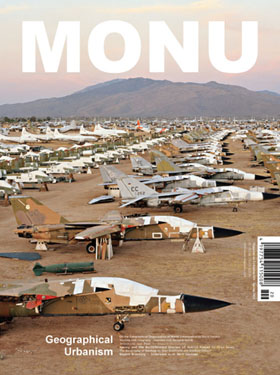






Order a copy of MONU #20 here.
(browse
the entire issue #20 on Youtube)
On the Geographical Organization of World Urbanization by Nikos Katsikis;
A Geographic Stroll Around the Horizon by Rania Ghosn and El Hadi Jazairy;
22º54´S 43º 10'W by Michael Oliveira; We Dig Your
Land by David Morison; Working with Geography - Interview with
Bernardo Secchi by Bernd Upmeyer; Underneath it All: Geo Urbanism
by Jessica Bridger; Strait by Neyran Turan; Geography
and the Identity of Fear: The Other Battle of Mexico City by Felipe Orensanz;
Post-Human Tectonics - A Geology of Power by Roger Hubeli; Seduction
and Fear by Edward Burtynsky; Valleys, Rivers, Pathways: Narrating
the Urban Landscape by Thomas Kohlwein; Contested Terrain: In
Search of Niagara by Kees Lokman; Agency and the Multifaceted
Stories of Hybrid Places by Ryan Dewey; The Contour and the Block
by Lucas Correa-Sevilla and Pablo Pérez-Ramos; Urban Fringe
Landscapes on Mountains by Maider Uriarte Idiazabal; The Geography
of Geology by Sean Burkholder and Bradford Watson; Geography,
Urbanism's Critical Cousin by Christopher de Vries; Urbanism After
Geography: The Network is Context by Clare Lyster; Beyond Branding
- Interview with Bart Lootsma by Bernd Upmeyer
Contrary to the simplified linear causality of the environmentalism of the
past, which posited that natural geography shapes urban patterns, it is now
thought that contemporary urbanization shapes the surface of the earth. Nikos
Katsikis explains this tremendous current shift in the meaning of physical
geography for cities in his contribution "On the Geographical Organization
of World Urbanization", putting the discussion of the 20th issue
of MONU on the topic "Geographical Urbanism"
in a historical context. For Bernardo Secchi this is not much
of a problem as he is no fan of natural geography anyway, a position he reveals
in our interview with him entitled "Working with Geography".
According to him our task today is to understand, and to learn from, natural
geography, but to correct and improve it and design useful projects of artificial
geography. What is important to him - and which is the reason why he considers
physical geography the starting point of all his ideas on planning - is that
over time people transform geography, and especially topography, into topology,
something that concerns social, economic, spatial, and phenomenological interactions.
To what extremes natural geographies can be manufactured is shown by Edward
Burtynsky in his series of photographs entitled "Seduction and
Fear". However, the natural geographical features in his images are
not only introduced as victims, but also as partners, protagonists, baits, sources,
threats, and pleasures. How such manufacturing can result in hybrid places,
with bridges and buildings to our left and rivers to our right, where rural
forms intermingle with urban forms and geography penetrates the city, is described
by Ryan Dewey in his piece "Agency and the Multifaceted
Stories of Hybrid Places". In these hybrid locations cities and geographies
converge in a story of identity and imageability, turning "Geographical
Urbanism" into a sort of autobiographical tale, in which geography
provides us with a kind of physical scaffolding that allows us to use land as
a place to store our memories. That way, physical geography becomes more meaningful
for cities than something that is merely used for its picturesque qualities
or resource value as Sean Burkholder and Bradford Watson
state in their article "The Geography of Geology". Because
cities and landscapes are much more complex than that, and can generate - together
with the inhabitants - a multiplicity of narratives as Bart Lootsma
emphasizes in our interview with him entitled "Beyond Branding".
Although he believes that there are aspects of, for example, the "Generic
City" that are absolutely true, yet he does not find them necessarily threatening,
he is convinced that no city will ever be the same because of natural geography.
He even thinks that it is crucial for architects and urban designers to reconnect
with geographers - not just to achieve better and smarter planning and design
but, to put it more dramatically, also to save our democracies and develop them
further.
(Bernd
Upmeyer, Editor-in-Chief, April 2014)
(Cover: Image “AMARC#3; Tucson, Arizona, USA, 2006”
from Edward Burtynsky’s contribution “Seduction and Fear”.
Photo ©Edward Burtynsky, courtesy Nicholas Metivier Gallery, Toronto/ Flowers,
London.)
14-10-13
// MONU #19 - GREATER URBANISM
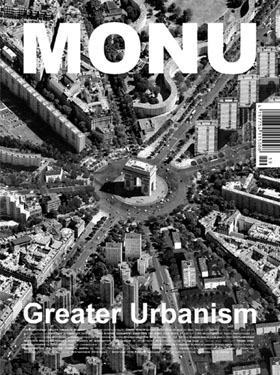





Order a copy of MONU #19 here.
(browse
the entire issue #19 on Youtube)
Unlimited Greatness - Interview with Antoine Grumbach by Beatriz Ramo
and Bernd Upmeyer; Greater Moscow by Anton Ivanov; From
Utopia to Real World by Fabrizia Berlingieri and Manuela Triggianese;
Grand Paris by Rogers Stirk Harbour + Partners; Greater Singapore:
Exporting the Model City-State by Calvin Chua; Metro-Detroit Faith
Territories by McLain Clutter; Out of Obscurity by Magorzata
Kuciewicz and Simone De Iacobis; Metrocology: The City Unseen by
Tom Marble; Fragmentation vs. Unification by OMA/ Text by Clément
Blanchet; One Hundred and Ninety-Nine Miles by Rob Holmes;
A Brief History of Speculative Urbanization by Christopher Marcinkoski;
Life on the Edge by Hannah Hunt Moeller; Skopje, Great, Greater,
Grandeur by Ognen Marina; Greater Connections by James
Khamsi and Emily Goldman; Crushed Ground - The Fragmented Territory of
Austerity-Stricken Athens by Panos Dragonas; Reconsidering the
Greater Urbanism Agenda by Petros Phokaides, Iris Polyzos, and Loukas
Triantis; Facemap by Julie Bogdanowicz; Notes Towards a
Botanical Urbanism by Jennifer W. Leung; Metropolitan Strategies
- Interview with Rikhard Manninen by Bernd Upmeyer; From the Kremlin
to Dachas by Flavien Menu
It appears that cities of today, and especially big cities, all around the
world, are all struggling with similar problems, as they all have developed
huge territories - their metropolitan or "greater" areas
- during the twentieth century that cannot be properly understood by anyone
in terms of their form, but that now need to be recognized as something that
truly exists, because it is a form that is in perpetual transformation and without
limits.This is where Antoine Grumbach sees the main difficulty
when it comes to "Greater Urbanism" as he explains in
an interview with us entitled "Unlimited Greatness". In such
unlimited spaces infrastructure plays without doubt a crucial role constructing
a connected geography and reconfiguring new urban morphologies, as Fabrizia
Berlingieri and Manuela Triggianese argue in their piece
"From Utopia to Real World - Construction of a Unique Metropolitan Space
of Europe". But a metropolitan strategy that focuses exclusively on
mass transport remains incomplete, as is demonstrated by Rogers Stirk
Harbour + Partners in their contribution "Grand Paris".
They argue that the voices of the metropolitan region outside the centre demand
representation. To what extent architecture can visually address and represent
the urban public in "greater areas" is shown by McLain
Clutter in his piece "Metro-Detroit Faith Territories",
pointing out the unique ability of mega-churches to condense a collective domain
within exurban sprawl, a morphology of urbanization that is notorious for atomization.
Such peripheral areas may even become gateways to their urban centers, as is
illustrated by the Office for Metropolitan Architecture (OMA)
in its contribution "Fragmentation vs. Unification". But that
the quality of "Greater Urbanism" is not necessarily
dependent on spatial issues is clarified by Hannah Hunt Moeller
in her article "Life on the Edge: Peri-Urban Borders of the Greater
Urban Milieu", showing how the very lack of defined spatial boundaries
enables self-determination. In that way, "Greater Urbanism"
can be liberated from the perceived need to control everything, can become free
to fill, for example, niches in the market and a method that is used in response
to desires as James Khamsi and Emily Goldman describe
it in their contribution "Greater Connections: Infrastructures of Mobility
and Design Agency beyond the City". However, that such possibilities
do not relieve state governments and city municipalities of their duty of establishing
and creating overall and coherent visions for "greater"
urban areas, thereby arresting the tendency that those areas are being shaped
by a multiplicity of private actors, is pointed out by Petros Phokaides,
Iris Polyzos, and Loukas Triantis in their piece "Reconsidering
the Greater Urbanism Agenda: Crisis, Planning and Architecture in Metropolitan
Athens". Only then will it be possible to address the biggest challenges
of "Greater Urbanism" that Rikhard Manninen,
the head of the Strategic Planning Division in the City Planning Department
of Helsinki, whom we interviewed about "Metropolitan Strategies",
discerns in the continued management of city structures during periods of significant
growth - having no sprawl, while attracting a sufficient workforce to meet the
demands of an ageing population, and aiming for city-regions that take climate
change into account through carbon neutral developments.
(Bernd Upmeyer, Editor-in-Chief, October 2013)
(Cover image: 'The 'Étoile' of Grand Paris - The Radiant Typologies
of Greater Paris' is courtesy of STAR
strategies + architecture and BOARD.
The image, featuring the Arc de Triomphe surrounded by the typologies of Grand
Paris, is part of their research project "Construisons le Grand Paris
Ensemble - Or the Story of How Paris Became Greater". This story is
the first legend of the Parisian territory, in which Paris had to die to save
Grand Paris. The project was realized by STAR and BOARD as part of the Scientific
Committee of the AIGP - Atelier International du Grand Paris, in the framework
of "Systèmes Métropolitains", presented and delivered
in September 2013.)
23-04-13 // MONU #18 - COMMUNAL URBANISM
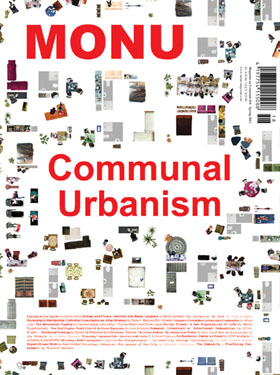






Order a copy of MONU #18 here.
(browse
the entire issue #18 on Youtube)
Learning to Live Together by Martin Abbott; Ecstasy and Privacy
- Interview with Rainer Langhans by Bernd Upmeyer; The Centennial
RV Park by Lisa Hirmer; Ownership to Membership: Collective Consumption
as Urban Strategy by Travis K. Bost and Eric Höweler; Voluntary
Crowdedness in Innovative Communities by Alfredo Andia; Two Generations
Together by Yasmine Abbas, Lara Jaillon, Thomas Watkin, and Onnis Luque;
Soviet Dreams: A New Organisation of Life by Matas Šiupšinskas;
New Deal Utopias: Model Cities of the Great Depression by Jason
Reblando; Communal Intentions or Intentional Communities by Ernst
Gruber; Communal Housing by Sylvain De Bleeckere and Sebastiaan
Gerards; The Urban Kibbutz - Revolution from Within by Maier Yagod;
The Architecture of the Kibbutz by Freddy Kahana; Promoting
Communal Life - Interview with Atelier 5 by Bernd Upmeyer; Co-Residence:
Habiter en Grand by STAR strategies + architecture and BOARD; Revisiting
a Built Communism by Ling Fan; The Chengzhongcun - Collectivity
through Individuality by John Joseph Burns; Unpaid (House) Work
by Adam Holland; Voluntary Urbanism: The Agency of the City by
Michaël Oliveira; The Community - Practising Commitment by
Richard Sennett
How should we live together? is the central question of this 18th
issue of MONU on the topic of "Communal Urbanism",
focusing on contemporary communal living in cities. According to Martin
Abbott's contribution "Learning to Live Together",
this is a question often discussed among the housemates of Berlin's 40 year
old communal "Hausprojekt Walde". Rainer Langhans,
one of the early members of the legendary "Kommune 1",
founded in Berlin in 1967, is convinced that in the future we will live increasingly
communally. He sees a growing demand for, and interest in, communal life and
shared experiences as he explains in our interview with him entitled "Privacy
and Ecstasy". But in contrast to his own experiences in Kommune
1, where he experienced an uninterrupted, 24/7, spiritual communal ecstasy
of love, the communal life of the future will instead be characterized by temporary
communities, where people meet and share spaces, facilities and experiences
occasionally, similar to his own current communal life. That way cooperation
does not come at the expense of our individualism and is focused on membership
rather than ownership as Travis K. Bost and Eric Höweler
clarify in their piece "Ownership to Membership: Collective Consumption
as Urban Strategy". Yasmine Abbas, Lara Jaillon, Thomas Watkin,
and Onnis Luque explain in their article "Two Generations
Together" how communal life might be an answer to present urban challenges
that appeared due to increasing social fragmentation, weak or fragile economies
and the burst of the housing bubble that pushed many countries to the edge of
acceptable standards of living. History has shown that communal and cooperative
life can lead to numerous benefits for everybody involved. For example, America
met the challenges of the Great Depression in the 1930s in the spirit of cooperation
as Jason Reblando illustrates in his contribution "New
Deal Utopias: Model Cities of the Great Depression". However, communal
urban life today has to provide a flexible platform for collaborative possibilities
and should no longer aim to provide a self-sufficient framework, but a lifestyle
that is stripped of the "forced socialization" of the shared forms
of life of the past as Maier Yagod describes in his piece "The
Urban Kibbutz - Revolution from Within". Such a platform, that could
be taken up and inhabited by people as an extension of and complement to their
own houses, is what the Swiss architecture collective Atelier 5
had in mind when it designed and built its famous "Siedlung Halen"
in the late 1950s and early 1960s, as Heinz Müller, one of
the current partners of Atelier 5, puts it in our interview with
him entitled "Promoting Communal Life". STAR strategies
+ architecture and BOARD, in their contribution "Co-Residence:
Habiter en Grand", argue that the introduction of a new form of communal
life on the domestic scale of the apartment can contribute considerably to solving
the current problems on the metropolitan scale, whether of an economical, social,
or environmental nature. But the success of such a communal urbanism; and communal
housing in particular, relies on a high level of goodwill and participation
from all people and residents involved, as Adam Holland states
in his article "Unpaid (House) Work". Only then might the communal
experience of cooperation become a sustainable pleasure as Richard Sennett
explains in his piece "The Community - Practicing Commitment".
(Bernd Upmeyer, Editor-in-Chief, April 2013)
(Cover: Image courtesy of STAR strategies + architecture and BOARD.
The image is part of their contribution “Co-Residence: Habiter en Grand”
on the pages 89 - 96)
16-10-12 // MONU #17 - NEXT URBANISM
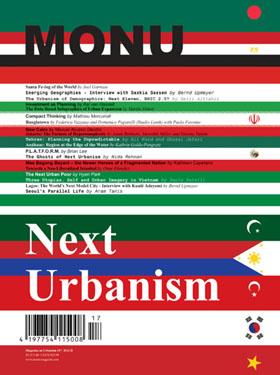






Order a copy of MONU #17 here.
(browse
the entire issue #17 on Youtube)
Santa Fe-ing of the World by Joel Garreau; Emerging Geographies:
From Environment to Terrorism - Interview with Saskia Sassen by Bernd
Upmeyer; The Urbanism of Demographics: Next Eleven, BRIC 2.0? by
Hajir Alttahir; Investment as Planning by Kai van Hasselt; The
Data Based Infographics of Urban Expansion by Martin Abbott; Compact
Thinking by Mathieu Mercuriali; Banglatown by Federica
Vazzana and Domenico Paparelli (Studio Lunik) with Paola Favoino; New
Cairo by Manuel Alvarez Diestro; Jakarta: Design Research and
the Futures of Hypercomplexity by Adam Bobbette, Meredith Miller, and
Etienne Turpin; Tehran: Planning the Unpredictable by Ali Fard
and Ghazal Jafari; Anáhuac: Region at the Edge of the Water by
Kathrin Golda-Pongratz; P.L.A.T.F.O.R.M. by Brian Lee; The
Ghosts of Next Urbanism by Nida Rehman; Mas Bagong Bayani - the
Newer Heroes of a Fragmented Nation by Kathleen Cayetano; Towards
a Neo-Liberalized Istanbul by Onur Ekmekci; The Next Urban Poor
by Hyeri Park; Three Utopias, Self and Urban Imagery in Vietnam
by Paolo Patelli; Lagos: World's Next Model City - Interview with
Kunlé Adeyemi by Bernd Upmeyer; Seoul's Parallel Life
by Aram Tanis
This new issue of MONU is dedicated entirely to the topic of "Next
Urbanism" - meaning the urbanism of the cities of the so-called
"Next Eleven" or "N-11", which
include eleven countries: Bangladesh, Egypt, Indonesia, Iran, Mexico,
Nigeria, Pakistan, the Philippines, Turkey, South Korea, and Vietnam.
These countries have been identified as growing into, along with the BRICs
- Brazil, Russia, India, and China - the world's largest economies in the 21st
century. Next to interviews with Saskia Sassen and with the Nigerian-born
architect Kunlé Adeyemi, and a series of contributions
that discuss Next Urbanism in general, we feature eleven articles
that focus specifically on the cities of each of the Next Eleven
countries. The issue opens with an article entitled "Santa Fe-ing the
World" by Joel Garreau, who envisions the future of the
Next Urbanism as being organized in dramatically different settlement
patterns that feature widely dispersed new aggregations, made possible by new
information technology, particularly the internet and cell phones. Although
these are far-fetched futuristic scenarios, being connected appears as the key
factor and an important asset that will determine the identity, character and
future of the Next Eleven cities. Saskia Sassen
describes something similar in our interview with her entitled "Emerging
Geographies - From Environment to Terrorism". Rather than thinking
in terms of "Next Eleven", a category that is -according
to her - based on lazy measures and an ignorance of the actual economies and
societies and geographies of those countries, she defines Next Urbanism
as emerging geographies and networks of cities that connect prosperous areas
of countries across the world that are better disposed to face our major global
challenges than national governments. Hajir Alttahir, in her contribution
"The Urbanism of Demographics: Next Eleven, BRIC 2.0?", unmasks
qualifications such as BRIC or Next Eleven as mere
marketing ploys, used by banks and targeted at potential investors. However,
from an investor's point of view, the concept of the Next Eleven group
of countries makes perfect sense as Kai van Hasselt points out
in his piece "Investment as Planning" in which he tries to
discover how cities and its citizens can profit from the concept and how the
act of investing can be seen as a process parallel to planning or even as a
form of planning itself. How important the need for investments is, for example,
in urban infrastructure and in particular in communication infrastructure in
the cities of the countries of the Next Eleven, is explained by
Federica Vazzana and Domenico Paparelli (Studio Lunik),
together with Paola Favoino, in "Banglatown",
which marks the first of the eleven articles focusing specifically on the distinct
qualities, identities, geographies, and vulnerabilities of the cities of one
of the Next Eleven countries - in this case Bangladesh. To what
extent, for example, are the areas of the city of Jakarta, despite being the
rising star of Indonesia, subject to unequal exposure to environmental risks,
disaster planning, and financial reorganization and management that may eventually
eclipse many forms of life that constitute the very 'cityness' of Jakarta? This
question is addressed by Adam Bobbette, Meredith Miller,
and Etienne Turpin in their piece "Jakarta: Design Research
and the Futures of Hypercomplexity". The fact that the cities of the
Next Eleven countries do not always function as the engines of economic
growth is shown by Nida Rehman in her contribution "The
Ghosts of Next Urbanism", in which she explains how the ghosts of unfinished
urban projects in Pakistan's city Lahore continue to haunt the city. Obviously,
there is a need still for a better understanding of the dynamics of the Next
Eleven cities to assure their successful future as Onur Ekmekci
clarifies in his article "Towards a Neo-Liberalized Istanbul"
in which he describes the cities of the Next Eleven, and particularly
the city of Istanbul, as "worlding cities": inherently unstable, inevitably
subject to intense competition, always incomplete. In the words of the urban
theorist Ananya Roy: 'the art of being global'. Altogether the eleven articles
that focus specifically on the cities of the different Next Eleven
countries provide a broad overview of what Next Urbanism looks
like today and will look like in the future. And despite their problems, it
appears that if each of their economies is able to address the specific conditions
needed to maintain growth, as Hajir Alttahir explains, the emerging
architecture and urbanism of the Next Eleven, although more muted
than BRIC in terms of development, may end up surprising us all
with their innovative strength, and will act as a paradigm for a new networked,
high-density, and resilient urbanism. According to Kunlé Adeyemi
the cities of the Global South are already the cities of the moment:
he perceives the Nigerian city of Lagos to be the global model city, as he explains
in our interview with him entitled "Lagos: The World's Next Model City".
(Bernd Upmeyer, Editor-in-Chief, October 2012)
This issue is supported by the Creative
Industries Fund NL.
17-04-12 // MONU #16 - NON-URBANISM
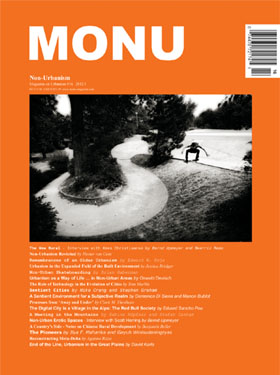






Sold out.
(browse the entire issue
#16 on Vimeo)
The New Rural: Global Agriculture, Desakotas and Freak Farms - Interview with
Kees Christiaanse by Bernd Upmeyer and Beatriz Ramo Page; Non-Urbanism
Revisited by Hester van Gent; Remembrances of an Older
Urbanism by Edward W. Soja; Urbanism in the Expanded
Field of the Built Environment by Jessica Bridger; Non-Urban
Skateboarding by Brian Gaberman; Urbanism as a Way of Life
… in Non-Urban Areas by Oswald Devisch; The Role of Technology
in the Evolution of Cities by Tom Marble; Sentient Cities: Ambient
Intelligence and the Politics of Urban Space by Mike Crang and Stephen
Graham; A Sentient Environment for a Subjective Realm by Domenico
Di Siena and Manon Bublot; Processes from 'Away and Under' by
Clark M. Thenhaus; The Digital City is a Village in the Alps: The Red
Bull Society by Eduard Sancho Pou; A Meeting in the Mountains
by Sabine Höpfner and Stefan Canham; Non-Urban Erotic Spaces
- Interview with Scott Herring by Bernd Upmeyer; A Country's Side
- Notes on Chinese Rural Development by Benjamin Beller; The Pioneers:
Mutation Agent of the Non-Urban by Ilya F. Maharika and Gayuh Winisudaningtyas;
Reconstructing Meta-Doha by Agatino Rizzo; End of the Line,
Urbanism in the Great Plains by David Karle
The rural as a strict counterpart to the urban appears to
be a condition of the past. At least, this is what Kees Christiaanse
posits in an interview with us entitled "The New Rural: Global Agriculture,
Desakotas, and Freak Farms". He points out that, today, non-urban spaces
interact so frequently and intensely with urbanity that you can no longer describe
something as strictly rural. Therefore, we can no longer separate the city from
the countryside as these are not polarized entities and each other's enemies,
but rather the result of each other. Evidently, to be an urbanist today means
that one must also be a regionalist as Edward W. Soja puts it
in his contribution "Remembrances of an Older Urbanism". In
relation to that, Oswald Devisch reminds us in his piece "Urbanism
as a Way of Life…in Non-Urban Areas" that the 1930s sociologist
Louis Wirth stressed that the concept of urbanism is something not only confined
to large, dense and heterogeneous settlements, but can also manifest itself
to varying degrees "wherever the influences of the city reach". In
that sense Devisch thinks that it is time to change the urban
- non-urban dichotomy into a dynamic - stagnant version that is based on social
rather than spatial conditions. Obviously, new media and especially the internet
play an important role in the discussion on Non-Urbanism as spaces
around us are now being continually forged and reforged in informational processes
as Mike Crang and Stephen Graham explain in their
contribution entitled "Sentient Cities: Ambient Intelligence and the
Politics of Urban Space". In their article they describe a world in
which we not only think of cities, but cities also think of us, and in which
the environment reflexively monitors our behavior. In his piece "Processes
from 'Away and Under'", Clark M. Thenhaus envisions -
because of those informational processes and in particular increased digitalization
- no future widening of the gap between the urban and the non-urban, but rather
that gap being bridged. This 'bridging' will occur only partially through physical
manifestations, but largely through otherwise 'invisible' structures and open-source
processes and networks. Although the limits of digital cities are usually not
physical, but, for example, economic as Eduard Sancho Pou describes
in his contribution "The Digital City is a Village in the Alps: The
Red Bull Society", one might find - especially in non-urban areas
- "Truman Show"-like physical manifestations such as the village of
the multinational corporation "Red Bull". But non-urban spaces are
also changing independently from the influence of the internet and social media,
particularly in emerging market economies such as China, India or Indonesia.
According to Scott Herring rural conditions have actually been
changing ever since there this idea of a country and a city emerged, as he explains
in another interview with us entitled "Non-Urban Erotic Spaces".
In Indonesia, for example, so-called desakotas, hybrid spaces between the countryside
and the city, appear as transitory spaces that lead eventually to the rise of
the city of the non-urban as Ilya Fadjar Maharika and Gayuh
Winisudaningtyas put it in their article "The Pioneers: Mutation
Agent of the Non-Urban". In such a 'non-urban city' so-called pioneers
convert agriculture into urbanized spaces with a population density double that
of the countryside, into a non-urban urbanism. However, the future viability
of those non-urban urban spaces remains in doubt as a typical
transformation process of rural spaces - especially in Asia - means that the
rural self-supporting local ecology of farming gradually vanishes as a lot of
farmers go bankrupt and feudal proprietors or large multinational agro-companies
take over the land as described by Kees Christianse. In order
to survive, formerly independent rural communities, such as the ones in the
US that David Karle mentions in his contribution "End
of the Line, Urbanism in the Great Plains", must transition to self-sustaining
micro-regional networks.
(Bernd Upmeyer, Editor-in-Chief, April 2012)
21-11-11 // MONU #15 - POST-IDEOLOGICAL URBANISM
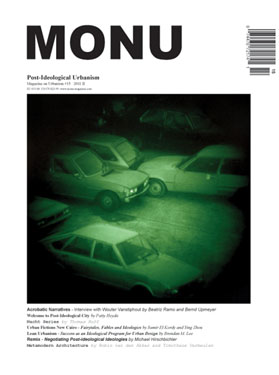






Order a copy of MONU #15 here.
(browse
the entire issue #15 on YouTube)
Acrobatic Narratives - Interview with Wouter Vanstiphout by Beatriz Ramo
and Bernd Upmeyer; Welcome to Post-Ideological City by Patty Heyda;
Nacht Series by Thomas Ruff; Urban Fictions New Cairo - Fairytales,
Fables and Ideologies by Samir El Kordy and Ying Zhou; Lean Urbanism
by Brendan M. Lee; Towards a Political Urbanism by Adrià
Carbonell; The Khmer Rouge and the Control of Urban Space by Fredrik
Torisson; Spaces Of Negotiation by DoUC (Brendan Cormier, Christopher
Pandolfi, and Simon Rabyniuk); Post(card) Ideological by Nathalie
Frankowski and Cruz Garcia (WAI Architecture Think Tank); Remix - Negotiating
Post-ideological Ideologies by Michael Hirschbichler; Metamodern
Architecture by Robin van den Akker and Timotheus Vermeulen; Slipstreaming
by Gale Fulton and Stewart Hicks; Greetings from Post-Everything
by Mika Savela; O'Mighty Green by Beatriz Ramo - STAR strategies
+ architecture; Other Dimensions by Wes Wilson; Infra-/
Eco-/ Logi-/ -Urbanism by Geoffrey Thün, Kathy Velikov, and Colin
Ripley (RVTR); Choose Your Own Urbanism Presents: The Case of the Missing
Ideal By Melissa Dittmer, Jamie Witherspoon, and Noah Resnick
This new MONU issue on the topic of Post-Ideological Urbanism probably
touches on one of the most fascinating and biggest issues of our time and in
our culture, or what is left of it: the non-ideological - or better post-ideological
- conditions of our society when it comes to cities. Today, ideology appears
to have become, and to have been reduced to, something merely aesthetic, something
you can buy yourself into as Wouter Vanstiphout explains in an
interview with us entitled "Acrobatic Narratives". In that
sense cities have become suspicious territories where hypocrisy and fakery prevail
when it comes to urban ideologies and one wishes to have some kind of optical
device that detects all the lies, similar to a kind of night vision infrared
technology that Thomas Ruff used in his "Nacht Series"
applying the same technology that was used during the Gulf War. But the usage
of alibi ideologies does not seem to be just a contemporary phenomenon and the
inference that, for example, the heroic Modernist architects and urban designers
were able to work without succumbing to the moral ambiguities of dealing with
external political or economic contingencies is probably a fallacy as Brendan
M. Lee states in his contribution "Lean Urbanism".
He furthermore explains that we, architects and urban designers, are sometimes
envious of our Modernist forebears for their supposed ability to remain true
believers in the revolutionary ideologies they proselytized, but that perhaps
we have lost the self-confidence in our own ability to bluff. Fredrik
Torisson even questions the necessity to follow one coherent system
of ideas or an ethical set of ideals in his piece "The Khmer Rouge and
the Control of Urban Space" and disqualifies urban ideology as a homogenizer
that elevates one preferred ideal over the many. But according to Michael
Hirschbichler and his analytical manifesto "Remix - Negotiating
Post-ideological Ideologies" there cannot in fact be a post-ideological
condition as there is no society imaginable that could exist beyond an ideological
framework and is totally free from ideological contexts. What appears to be
post-ideological today is in fact the coexistence, silent combat and mutual
neglect of innumerable ideologies, neo-ideologies and pseudo-ideologies. In
this pluralistic environment, no single ideology or group of ideologies is perceived
to be relevant enough to become a point of reference or a single desirable truth.
Robin van den Akker and Timotheus Vermeulen describe
this prevailing pluralism, or coexistence, in their article "Metamodern
Architecture" as metamodern, a condition in which the contemporary
structure of feeling evokes a continuous oscillation between seemingly modern
strategies and ostensibly postmodern tactics as well as a series of practices
ultimately beyond these worn out categories. Following the authors, that kind
of metamodernism can be observed in the art works of for example Djurberg, the
quirky cinema of Gondry the novels of Murakami or the music of Coco Rosie and
movements as diverse as reconstructivism, the new romanticism and the new sincerity.
And a new sincerity is obviously needed in a world consisting of a multiplicity
of choices and urban outcomes without a single consistent urban ideology as
Melissa Dittmer, Jamie Witherspoon, and Noah Resnick
point out in their piece "Choose Your Own Urbanism Presents: The Case
of the Missing Ideal".
(Bernd Upmeyer, Editor-in-Chief, November 2011)
18-04-11 // MONU #14 - EDITING URBANISM
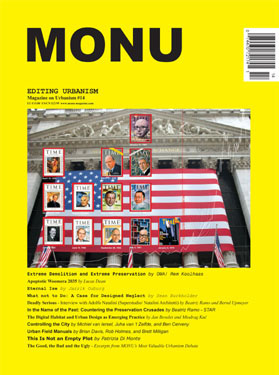








Order a copy of MONU #14 here.
(browse
the entire issue #14 on YouTube)
The Naked Lunch: A Stark Honest Discussion On Renewal by UNION3; On
Politics of Planning by Henk Ovink; Beyond Editing by
Simone Pizzagalli; Extreme Demolition and Extreme Preservation
by OMA; Apoptotic Woomera 2035 by Lucas Dean;
Eternal Ise by Jarrik Ouburg; Moveable Chair
by Sara Hendren; What not to Do: A Case for Designed Neglect
by Sean Burkholder; Deadly Serious - Interview with Adolfo
Natalini by Beatriz Ramo and Bernd Upmeyer; In the Name
of the Past by Beatriz Ramo - STAR strategies + architecture; Cultural
Editors by Paul Meurs and Marinke Steenhuis; The Digital
Habitat and Urban Design as Emerging Practice by Jan Bovelet and Miodrag
Kuc; Between Material and Culture by Ephraim Joris;
Controlling the City by Michiel van Iersel, Juha van 't Zelfde,
and Ben Cerveny; Layered Reality by Gijs Hoofs and Michiel
Daalmans; Urban Field Manuals by Brian Davis, Rob Holmes,
and Brett Milligan; This Is Not an Empty Plot by Patrizia
Di Monte; The Good, the Bad and the Ugly - Excerpts from MONU's
Most Valuable Urbanism Debate
Despite the current urgency to deal with the enormous potential of the already
existing urban material as Urban Editors, there seems still to
be an enormous lack of interest in topics such as urban and architectural restoration,
preservation, renovation, redevelopment, renewal or adaptive reuse of old structures
among architects and urban designers. But ignorance in this matter can only
be dismissed as socially irresponsible and economically and culturally unacceptable.
But what might be the reason for the prevailing ignorance? Who is to blame?
Why is Urban Editing considered to be so utterly unattractive?
Felix Madrazo, one of the members of the UNION3
collective, blames the media and in particular architecture publications, as
he points out in UNION3's discussion of urban renewal entitled "The
Naked Lunch: A Stark Honest Discussion on Renewal". He states that
a prestigious architectural magazine such as the Spanish El Croquis would never
publish an architect who has been practicing renewal for the last twenty years.
In OMA's contribution "Extreme Demolition and Extreme
Preservation" Rem Koolhaas holds the arrogance of the
modernists responsible for making the preservationist of today look like a futile
and irrelevant figure. He furthermore claims that preservation necessitates
the development of a theory of its opposite: not what to keep, but what to give
up, what to erase and what to abandon - and proposes a system of phased demolition.
To a certain extent this is what Lucas Dean recommends in his
piece "Apoptotic Woomera 2035" for a small town in South Australia,
in which he suggests a programmed urban death that ensures that the urban fabric
can constantly undergo a process of rejuvenation. The concept is an analogy
to the biochemical process of apoptosis, which is organized cell death that
our bodies undergo on a daily basis, killing fifty to seventy million cells,
enabling the body to rejuvenate and ensure longevity. Obviously terms such as
death and rejuvenation are crucial notions when it comes to Editing Urbanism.
In his article "Eternal Ise" Jarrik Ouburg sees
destruction as a natural part of preservation. He advises to look east and learn
from the way how in Japan important shrines have been rebuild every twenty years
for more than ten centuries. But accepting death and decay in buildings is one
thing, when it comes to our own death, things get much more complicated. For
that reason Adolfo Natalini, one of the founders of the legendary
60ies architecture firm Superstudio, does not like physical changes
in cities, because they remind us that we are moving closer and closer towards
death, as he explains in an interview with us entitled "Deadly Serious".
He likes to be surrounded by things that remain the same as they give us the
impression of eternity and he sees architecture as the most powerful medium
of this form of hope. To solve the paradoxical situation that cities should
on the one hand remain the same, keeping and maintaining all their existing
buildings, yet on the other able to change, Beatriz Ramo / STAR
suggests in "In the Name of the Past: Countering the Preservation Crusades"
to establish Virtual World Heritage Sites as a new category for UNESCO. Virtual
preservation enables cities to survive for eternity in the virtual, yet remain
living and changing organisms in the real world. Released from the fear of death,
Editing Urbanism can become a vital, active and experimental
practice, in which the concept of sample and the remix gain importance as a
cultural technique as Jan Bovelet and Miodrag Kuc
describe in their contribution "The Digital Habitat and Urban Design
as Emerging Practice". Just as remixes of songs are alternative versions
of recorded songs, made from original versions, remixes of cities can be alternative
versions of the original cities. Especially with the help of hand-held devices,
mobile and digital online applications, citizens will be able to alternate and
control cities as Michiel van Iersel, Juha van't Zelfde,
and Ben Cerveny explain in their article "Controlling
the City". To edit cities successfully, Brian Davis,
Rob Holmes, and Brett Milligan even propose to
develop "Urban Field Manuals", which show how to change or
maintain your city just as automotive maintenance manuals teach you how to repair
or maintain your car. Such Urban Field Manuals allow you for example to learn
how, as a non-profit landlord, to approach buildings that are awaiting demolition
permissions for a new construction on old properties, and to format micro-contracts
that make unoccupied buildings available to other non-profits at the costs of
utilities alone. But one of the most successful strategies for such reuse of
unoccupied spaces in cities has probably been developed by Patrizia Di
Monte recently. In her contribution "This Is Not an Empty Plot",
she shows how she created an employment plan, in which sixty one long-term unemployed
workers cleaned initially empty plots of the historic district of Zaragoza,
which led eventually to the realization of twenty-eight projects on those lots
over the last two years.
(Bernd Upmeyer, Editor-in-Chief, April 2011)
This issue is supported by the Creative
Industries Fund NL.
05-10-10 // MONU #13 - MOST VALUABLE URBANISM
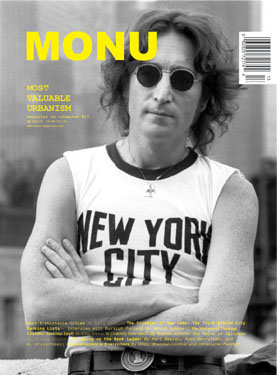






Order a copy of MONU #13 here.
(browse
the entire issue #13 on YouTube)
Most T-shirtable Cities By Mika Savela; Evaluation City - Post
Industrial’s Most Valuable Urbanism By Melissa Dittmer and Amy Bos;
Within a Day By Bobby Shen; Urban Perception of Happiness By
Luciano Alfaya and Patricia Muñiz; The Urban Rhythm By
Karin Aue and Jeffrey Koh; Tales of Nail Houses By Human
Wu; Wonder Full By Bas van der Horst, Hans Larsson, and
Michiel van Loon; The Crumbles of the Cake - Interview with Ruraigh Purcell
By Bernd Upmeyer; The Systematic Thinking Livability Rankings
Imply By Klaas Kresse; Is Livability Overrated? Notes on
a Transactional Urbanism By Matthew Johnson; Berlin Tempelhofer
Feld – A Field for the Public By Hans Frei; L.A.’s
Optimistic Urbanism By John Southern; The Value of Ugliness
By Jürgen Krusche; The Strategic City By Jennifer
W. Leung; Climbing up the Rank Ladder By Karl Beelen, Roos
Gerritsen, and A. Srivathsan; Vancouverism is Everywhere By
DoUC (Brendan Cormier and Christopher Pandolfi); Vienna: Slow
capital? By Stefan Gruber
When John Lennon was photographed by the legendary rock 'n'
roll photographer Bob Gruen, wearing a New York City T-shirt in
the year 1974, he proudly expressed his love for the city of New York. For Lennon,
although born in Liverpool, New York City was without doubt the most valuable
city. In that sense the value of a city can become extremely personal, subjective,
and only a reflection of feelings, as Mika Savela argues in his
contribution "Most T-shirtable Cities". Because of this
subjective experience the value of a city is - just as the beauty of a city
- in the eye of the beholder and what constitutes 'most valuable', in whatever
respect, shifts back into our hands, as Bobby Shen puts it in
his piece "Within a Day". People attribute a value to
spaces that cannot be quantified in statistical terms, but is dependent on how
'city users' identify with the place where they live, as Luciano Alfaya
and Patricia Muñiz explain in their article "Urban
Perception of Happiness". And this identification is usually based
on rather intangible criteria; social, cultural, and psychological dimensions;
or qualities such as history, identity, memories, or lifestyle, as Human
Wu illustrates in his piece "Tales of Nail Houses".
Nevertheless, it would be naïve to exclude certain basic physiological
needs out of the value discussion regarding cities. Those basic needs include,
for example, security, housing, or health as Ruraigh Purcell,
who spent several years running an analytical team producing city ranking lists,
points out in an interview with us entitled "The Crumbles of the
Cake - The Truth Behind City Ranking Lists". In his opinion, basic,
low-level needs have to be satisfied in a city, referring to Maslow's Hierarchy
of Needs, before you are in a position to move to a higher level of needs that
would take in account things such as educational and cultural stimulus. Most
of the evaluation criteria used by companies such as Mercer or the Economist
Intelligence Unit to produce the famous city ranking lists that define the so
called "most liveable cities", are based mainly on those basic needs.
But what is often less known is the fact that those ranking lists are not representative,
as they use as a primary source the answers of a particular socio-economic group:
expatriates. Klaas Kresse detects that fact in his text "The
Systematic Thinking Livability Rankings Imply" and discloses that
rankings are not made for the multiplicity of urban dwellers, but for a group
of wealthy, well-educated and highly skilled professionals. He furthermore points
out that the livability rankings imply an urban thinking in terms of closed
systems as cities start focusing on the points already scored, which makes them
static and inflexible. To continue being able to change Matthew Johnson
proposes in his piece "Is Livability Overrated?" that
cities should be allowed to exist in a state of perpetual upgrading and renovation
- always under scaffolding, in the form of a transactional urbanism. In his
eyes, Houston in Texas is such a transactional city that is evolutionary and
voracious, and secure in itself, despite its imperfections. Jürgen
Krusche misses such imperfections in the always top-ranked city of Zurich
as he clarifies in his contribution "The Value of Ugliness",
where the constant striving toward clean, safe, and beautiful public spaces
has banished unwelcome individuals from marginalized social groups from public
life. But ever since the Economist began some ten years ago to rate cities such
as Vancouver as the number one most livable city in the world, while other livability
indices by Mercer and Monocle Magazine also gave it consistently high rankings,
the safe and clean downtown living model of Vancouver became the planning model
for cities around the world, as Brendan Cormier and Christopher
Pandolfi explain in their article "Vancouverism is Everywhere".
Today, top positions in urban planning councils all over the world are filled
with Vancouverities. However, there seems to be a resistance towards Vancouverism
and there are possibilities to top livability ranking lists without following
the trends, as Stefan Gruber explains in his text "Vienna:
Slow Capital?", in which he suggests that the quality of life in
a city might also be determined by its capacity to resist certain movements
and instead to concentrate on its unique attributes.
(Bernd Upmeyer, Editor-in-Chief, October 2010)
This issue is supported by the Creative
Industries Fund NL.
11-03-10 // MONU #12 - REAL URBANISM
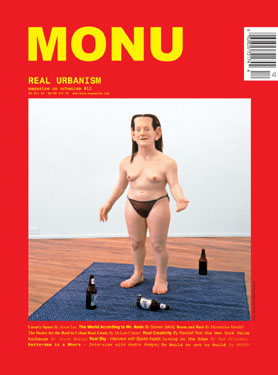





Order a copy of MONU #12 here.
(browse
the entire issue #12 on YouTube)
Luxury Space By Jason Lee; The World According to Mr. Reds
By Doreen Jakob; The Shelter Category By Mammoth (Stephen Becker
and Rob Holmes); How the City of Broad Shoulders Bought its Growth Spurt
By Karl Johann Hakken; Residential Developers and Investors in Central
Europe: Boom and Bust By Maximilian Mendel; Pyongyang in a New
Era By Yim Dongwoo; Casino City State By Rustam Mehta and
Thomas Moran; Solidere, Inc., or Downtown Beirut By Carol Moukheiber;
Real High - The Desire for the Real in Urban Real Estate By McLain
Clutter; Real Creativity: A Case for Ethical Freedom in Architecture
By Randall Teal; Life without Architects - Interview with Magriet
Smit By Bernd Upmeyer; The New York Value Exchange By Joyce
Hwang; Real Big - Interview with Bjarke Ingels By Beatriz Ramo;
Magic Realism - A New Skyline for Rome By Simone De Iacobis; Business
Park De Hoef Revisited 1998-2008 By Arjan Harbers (Topotronic); Brand
New Landlords By Daan Roggeveen and Michiel Hulshof; Market Value(s)
By STAR; Living on the Edge By Bas Princen; Why
should a Developer read Aristotle By Marta Relats; Unbuilt Rotterdam
By ZUS [Zones Urbaines Sensibles]; Rotterdam is a Whore - Interview
with Andre Kempe By Beatriz Ramo and Bernd Upmeyer; To Build or
not to Build By MVRDV
Just like
the "Ideal Woman" on the cover of this issue on Real
Urbanism - a sculpture by the Brooklyn based artist Tony Matelli
- most of our cities are shaped by a particular set of values that does not
necessarily lead to high quality urban spaces, but instead to scary, ethically
unacceptable and distorted forms. As the "Ideal Woman", so "Ideal
Cities" can easily end up only fulfilling the wishes and dreams
of a powerful minority, but neglect the needs of most of the other people. Jason
Lee, one of the contributors to this issue, that deals more with "Real
Estate" Urbanism rather than with Actual or Factual Urbanism, uses
this sculpture in his article "Luxury Space" to display
the consequences that can occur when a financially powerful elite develops real
estate projects in the city of Shanghai merely to accommodate their consumerist
desires. Cities have been reduced to machines for making and spending money
as Stephen Becker and Rob Holmes put it in their
piece "The Shelter Category". Especially in Central
European countries, where two decades ago the state-controlled economy changed
into a market-economy, developers are driven by pure profit rather than by a
genuine desire or even awareness of sustainable neighbourhoods and city development
as Maximilian Mendel describes in his text "Residential
Developers and Investors in Central Europe: Boom and Bust". But
blaming only the financial elites and the real estate industry for the prevailing
urbanism of mediocrity would be too easy. For successful urban planning, cities
depend on private financing as Carol Moukheiber points out in
her contribution "Solidere, Inc., or Downtown Beirut",
where a productive collaboration between a corporate and a cooperative party
led - although heavily criticised and carried out in a kind of pseudo democratic
Berlusconian way - to prosperous results. In the case of Rotterdam, where the
municipality actually cares very little about the city, real estate developers
seem to be even more concerned about the quality of urban spaces than the city
itself, as stated by Andre Kempe in an interview with us entitled
"Rotterdam is a Whore". To halt the process by which
the built-up form of our cities continues to be mainly driven by practical concerns
such as efficiency, profit, and self-promotion, Randall Teal proposes
in his piece "Real Creativity: A Case for Ethical Freedom in Architecture"
that architects should become developers themselves. But how many architects
would be able and interested in doing that? Magriet Smit, a Rotterdam
based real estate developer, explains in the interview "Life without
Architects" that she actually tries more and more to avoid working
with planners and rather collaborates directly with construction companies as
they share a greater understanding of their profession. But to prevent our cities
from turning into monstrous "Ideal Cities", as perverted as the "Ideal
Woman", all the parties involved that are shaping the cities - the developers,
the municipalities and the planners - have to accept their interdependencies,
and have to try to understand the different interests of each party and have
to dare to navigate into unknown territory as Bjarke Ingels concludes
in an interview with us entitled "Real Big".
(Bernd Upmeyer, Editor-in-Chief, March 2010)
This issue is supported by the Creative
Industries Fund NL.
25-08-09 // MONU #11 - CLEAN URBANISM
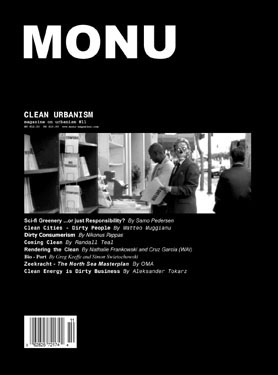





Sold out.
(browse
the entire issue #11 on YouTube)
Sci-fi
Greenery ...or just Responsibility? By Samo Pedersen; Clean
Cities - Dirty People By Matteo Muggianu; Dirty Consumerism
By Nikonus Pappas; Coming Clean By Randall Teal
; Domes over Manhattan - Interview with Gerd Hauser By Bernd Upmeyer;
Rendering the Clean By Nathalie Frankowski and Cruz Garcia (WAI);
The Mobile Library Unit By John Southern; Where the Grass
Is Greener By Tomorrow’sThoughtsToday; Clean around the Edges
By Lee Altman; Bio - Port By Greg Keeffe and Simon Swietochowski;
Zeekracht - The North Sea Masterplan By OMA; Scarcity:
Bipolar Urbanism in the Sonoran Desert By Felipe Correa; Regenerative
Ecologies By Claudio Astudillo Barra; Clean Energy is Dirty Business
By Aleksander Tokarz; Dystopic Verdure By Jacob Ross Boswell;
How to Win Poetic Praise and Influence Architects By Amanda Webb;
The Cooperative City By Rogier van den Berg; Mania By Bryan
Norwood and the Jackson Community Design Center
Do we simply
have to stop having sex to produce Clean Urbanism - i.e. an urbanism that is
dedicated to minimizing both the required inputs of energy, water, and food
for a city as well as its waste output of heat, air pollution as CO2, methan,
and water pollution, Samo Pedersen asks in his piece “Sci-fi
greenery..or just Responsibility?”. In fact Randall Teal
sees the growing world population frequently ignored in discussions on sustainability,
as he points out in his article “Coming Clean: Owning Up to the Real
Demands of a Sustainable Existence”. Fewer people spend less energy,
and as the gas and oil supply will come to an end sooner or later, saving energy
may be a cheaper and smarter solution for cities than depending on renewable
energies, as Gerd Hauser, one of the leading researchers on the
implementation of the EU Directive on Energy Performance of Buildings, explains
in an interview with us, entitled “Domes over Manhatten”.
Although sustainability has recently become a cache misère for our lack
of intent, a trendy make-up hiding our incompetence, with Clean Urbanism being
its apotheosis as Nathalie Frankowski and Cruz Garcia (WAI)
maintain in their contribution “Rendering the Clean”,
energy self-sufficient cities are technically possible as Gerd Hauser states
and explains using a five-point manifesto. Greg Keeffe and Simon Swietochowski
support that view by introducing their “Bio-Port” project,
a vision of a “Free Energy City” set in Liverpool, where
the old dockyards have been transformed into bio-productive algae farms. Furthermore,
the Office of Metropolitan Architecture (OMA) illustrates in its
project “Zeekracht – The North Sea Masterplan”
how wind farms could be clustered along an Energy Super-Ring in the North Sea,
distributing national surpluses and supplying regional energy needs efficiently
and profitably. On the other hand, Clean Urbanism cannot only be understood
from a purely technocratic perspective, but also needs a social one as Claudio
Astudillo Barra articulates in his article “Regenerative
Ecologies – A Prototypical Approach to the Territory”, introducing
Felix Guattari’s ideas of ecosophy. On such social aspects Rogier
van den Berg focuses in his piece on “The Cooperative City”,
where a community is created that triggers individual initiative and the cooperation
of its users to generate collective values. The Cooperative City requires a
flexible plan with an open end that is only guided by one set of rules, described
by Bryan Norwood and the Jackson Community Center
as “Mania: An Emergent Sustainability of Density and Intensity”,
created by the disorganized, hyperactivity of an actualized system with no specified,
singular goal, a bottom-up phenomenon that emerges from the individual events
of architecture within the city, combined with the ideology of urbanism conceived
as anti-capitalism and anti-homogenization. It is mania, and mania is clean.
(Bernd Upmeyer, Editor-in-Chief, August 2009)
06-02-09 // MONU #10 - HOLY URBANISM
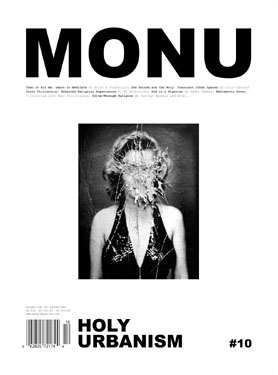





Sold out.
(browse
the entire issue #10 on YouTube)
A Mormon Megaproject by Daniel Hadley; Then It Hit Me: Learn
to Meditate by Brian A Shabaglian; The Sacred and the Holy: Transient
Urban Spaces by Colin Davies; Cross Utilization: Enhanced Religious
Experiences by NL Architects; Strata and Sound: The Adhan as an
Urban Operating Procedure by Peter Dorsey; The Sensory Experience
of Sacred Space: Senso-Ji and Meiji-Jungu, Tokyo by Raymond Lucas;
Peace Through Superior Horsepower by Speedism; God is a Nigerian
by Emeka Udemba; Emblematic Power - Interview with Kees Christiaanse;
Sacred Wire by Elliott Malkin; The Mormon Church’s
Infrastructure of Salvation by Jesse LeCavalier; Do not give up
Hope! by Maurizio Scarciglia; [uhn-hoh-lee] Alliance: A Domain
of Objects by Edward Richardson; Drive-Through Religion by
Carolyn Sponza; Urban Rituals by Abha Mahajan; Sacred Beauties
by Karen Crequer; Strucked by a Freak Wave by Matilde Cassani
Can the view on cities get any bigger than through religion? Probably not.
But we believe that a magazine on urbanism such as MONU, that appears only twice
a year, can never have a too open perspective. Although the picture in this
issue is big, and the contributions are diverse and have different focuses,
one thing can be found that runs through almost this entire issue on Holy Urbanism.
It is the convinction that Holy Urbanism in the contemporary city does not appear,
and is not created any longer, merely by religion itself, but rather by a crossbreed
of religion and economy. How such Holy Urbanism can be produced is explained
by Daniel Hadley, for example, through the City Creek Center in
Salt Lake City that quite clearly defies the dichotomy between market and temple
cities, in his article “A Mormon Megaproject”. Thus,
the City Creek Center is designed to be a centre of consumerism and economic
production, whose purpose, nevertheless, is to ensure vitality in front of the
nearby Temple Square. Sacred and commercial spaces seem increasingly to coalesce
and create a kind of Foucaultian Heterotopia, an environment that is capable
of juxtaposing in a single real place several spaces and several sites that
are in themselves incompatible, as Colin Davies points out in
his contribution “The Sacred and the Holy: Transient Urban Spaces”.
Peter Dorsey in his piece “Strata and Sound: The Adhan
as an Urban Operating Procedure” argues that contemporary Holy
Urbanism is flourishing especially at places where religion is creating a hybrid
together with capitalism. As an example he mentions the Lakewood Church Central
Campus in Houston, Texas that can seat more than 16.000 worshipers, adapting
efficiently into a spectacle-based environment by satisfying multiple consumer
appetites simultaneously. In the Nigerian city of Lagos the hybridisation processes
of religion and the market have even transformed the urban space itself into
a battlefield, in a free market where religion is a commodity to sell and an
urban survival strategy, as Emeka Udemba concludes in his “God
is a Nigerian”. Within such a capitalistic realm, religious buildings
follow an increasingly territorial logic that is similar to capitalistic corporations
or franchises such as McDonald’s or Starbucks. The Church of Jesus Christ
of Latter-Day Saints, for example, standardized the design of their temples
and thus created a generic network of identical buildings that are spread out
- Starbucks-like - all over the planet, as Jesse LeCavalier illustrates
in his article “The Mormon Church’s Infrastructure of Salvation”.
Carolyn Sponza, in her contribution “Drive-Through-Religion”,
even states that in the United States, planning a church and a shopping mall
always begins with the same capitalistic question – how much parking the
site can accommodate. Such an attitude leads in a lot of cases to the design
of big box, Ikea-like, building types that are perfectly located along a suburban
highway. But religious big boxes nevertheless - though convenient and visible
- force visitors to seek them out, park their cars, and walk toward their front
doors. And if you don’t think it’s for you, you can keep driving along
the highway until the next big box containing another religion grabs your attention.
Such Holy Urbanism promotes religious choice and makes multi-religious spaces
possible that are flexible as pieces of fashion, as empty spaces for inter-religious
dialogue that incarnate the belief in a multi-faith society and allow for openness,
and heterogeneity as Karen Crequer reveals in her piece “Sacred
Beauties”.
(Bernd Upmeyer, Editor-in-Chief, February 2009)
26-08-08 // MONU #9 - EXOTIC URBANISM
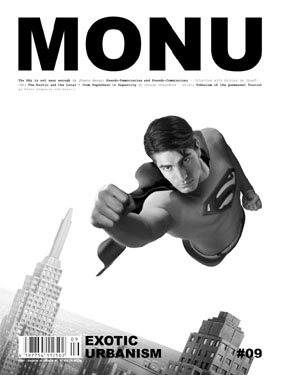





Order a copy of MONU #9 here.
(browse the entire issue #9 on YouTube)
A City under the Influence by Vesta Nele Zareh; Cities of Girl
by Laurent Gutierrez and Valérie Portefaix/ Map Office; Thawing
Urbanisms in the Arctic by Mason White and Lola Sheppard; Living
Facades - Green Urbanism and the Politics of Urban Offsetting by Owen
Hatherley; Flying Grass Carpet by Joop de Boer; The 'Great
Comeback' of The Chinese to Katendrecht by Els Vervloesem; Urbanism
of the permanent Tourist by Deane Simpson; Plastic Wrapped History
by Hannah Epstein; Golf Courses and Cultural Conventions of Nature
by Jacqueline Schlossman; The Sky is not near enough by Shumon
Basar; Defining the Exotic when Identity is Lost by Yasmine El
Rashidi; Nondescript Exotism inside the Urban Tissue by Anne Seghers;
Pseudo-Democracies and Pseudo-Commissions - Interview with Reinier
de Graaf/ OMA by Bernd Upmeyer and Beatriz Ramo; Elite Commune
by Lei Liu; Re-fun by Yaowalak Baltisberger; Urbanism
in a Minor Key by Gean Moreno and Ernesto Oroza; The Exotic and
the Local - From Superhero to Supercity by Yehuda Greenfield - Gilat
In this issue we have taken the deliberate risk of making ourselves look
ridiculous by focusing its theme on "the exotic", which is often seen
as some sort of worn out, utterly out of date topic, immediately evoking images
of colonialism and imperialism. But what fascinated us right from the beginning,
since this topic idea of exotic urbanism popped up in our minds, is - without
any irony - the opportunity to shift the perception towards global urban phenomena,
into a direction that does not necessarily focus on the question how cities
more and more become the same through their global battle and competition to
attract more urban assets, but how they can actually become more different despite
an ever - expanding exchange and an increasingly accelerating process of interaction.
On that question this issue of MONU provides a magnificent collection of exuberant
essays and projects. There is something very paradoxical about the exotic in
an urban context. When a city like Tehran, for example, started importing western
planning models around 200 years ago, it tried to distinguish itself from conventional
structures but also from other cities, as Vesta Nele Zareh has
illustrated in her article "A City under the Influence".
This could also be interpreted as an excursion into a brashly beautiful but
savage and unforgiving territory as Owen Hatherley puts it in
his piece about "Green Urbanism and the Politics of Urban Offsetting".
Such exotic urban elements also seemed to deliver the possibility to escape
from everyday surroundings and to experience the feeling of entering another
world without leaving your actual urban realm as Deane Simpson
describes it in his text on the "Urbanism of the permanent Tourist".
But as soon as a certain critical mass of exotic urban elements has been implemented
in a city and a certain amount of time has passed, exotic elements can no longer
be distinguished from other elements, and especially not from the local elements.
Shumon Basar describes such a phenomenon in his contribution "The
Sky is not near enough" as a certain surreal salvation, where everything
slides into some sort of grey state between both poles, a kind of pseudo-local
or pseudo-exotic condition, something utterly unmemorable. Reinier de
Graaf, one of the partners of the Office for Metropolitan Architecture,
clarifies this neither-white-nor-black-condition in the whole current political
situation on the Eurasian continent in an interview with us entitled "Pseudo-Democracies
and Pseudo-Commissions". The conditions of the cities of the 21st
century can probably best be described with the term "pseudo" as a
result of the end of a black and white thinking, which gives the stage to dualistic
urban qualities. Cities become able, just as superheroes, to oscillate between
two different entities, one earthly and mundane, the other heroic and exotic
as part of their super-schedule as Yehuda Greenfield-Gilat investigates
in his piece on "The Exotic and the Local - From the Superhero to
the Supercity".
(Bernd Upmeyer, Editor-in-Chief, August 2008)
14-03-08 // MONU #8 - BORDER URBANISM
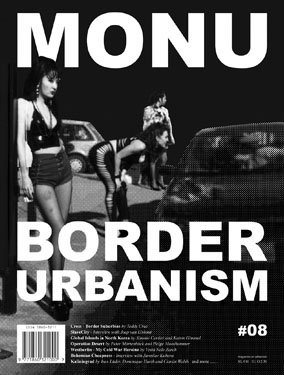





Sold out.
(browse the entire issue #8 on YouTube)
SlaveCity - Interview with Joep van Lieshout by Bernd Upmeyer;
Potential Nation States by STAR; Global Islands in North Korea
by Simone Cartier and Katrin Gimmel; Operation Desert by Peter
Mörtenböck and Helge Mooshammer; Kaliningrad by Ines
Lüder, Dominique Hurth and Ciarán Walsh; Segregated Istanbul
by Pelin Tan; Crisscrossing Lives by Horng-Chang Hsieh and
Vittaya Ruangrit; A Fictional Dialogue between two Curators by
Umi; Cross - Border Suburbias by Teddy Cruz; Reciprocal
Developments by Arjan Harbers and Kristin Jensen; Tijuana - Vernacular
by Federico Diaz de Leon Orraca; Border Models by Annemarie
Strihan; Bohemian Cheapness - Interview with Jaroslav Kubera by
Bernd Upmeyer; Sin City by Daan Roggeveen; On a Trip Down
Memory Lane by Lukas Feireiss; Windsor: The American Sector by
Justin A. Langlois; Westberlin - My Cold War Heroine by Vesta
Nele Zareh
Although we never intended to be a utopian magazine, when we started out we
were put into the same category as those small and short-lived radical periodicals
of the ‘60s and ‘70s. As a matter of fact we were never interested
in contemplating the fictional, yet perfect, socio-political urban conditions
or the possibility of the ideal society, however unrealistic. To the contrary,
we have always been fascinated by all the idiosyncrasies of reality, the conventional
and the pragmatic as an inexhaustible source of innovation. Nevertheless, in
this issue we provide some reflections on utopia. It appears to be the case
that cities located close to nation-state borders in particular, may be described
as isolated islands, where a different type of life seems possible, and as places
conducive to experiments and utopia as Ines Lüder, Dominique Hurth,
and Ciarán Walsh show in their article about the Russian enclave
Kalingrad. Border cities are often privileged as they are in a
position to determine their own rules. Joep van Lieshout created
with his highly sinister utopian art project “SlaveCity”
such an extreme case of self-rule, which he explains in an interview with us.
Switching back to reality, it may be said that nation-state borders seem to
have the most vigorous impact on cities when they appear in ‘doubles’
– i.e. one on each side of the border. Together they create a kind of symbiotic
urban love and hate relationship, a living together of dissimilar organizations,
which can lead to positive and negative “Reciprocal Developments”
between both cities as explored by Arjan Harbers and Kristin Jensen
in their case studies on Ceuta and Gibraltar. Teddy Cruz - in
his article “Cross-Border Suburbias” – describes
such relations between border cities as exposed landscapes of contradiction
where conditions of difference and sameness collide and overlap. But the clash
of different cultures and ideologies in two border cities of two different countries,
which are located close to each other, can also evoke severe identity conflicts
as is pointed out by Justin A. Langlois when he describes the
suffering of the Canadian city Windsor under the influence of
Americanization through its neighbor Detroit. The increase in such identity
conflicts between border cities can even transform cities into urban ideological
battlefields, where urban planning is utilized to gain political and cultural
supremacy, as it is shown by Vesta Nele Zareh in her piece about
the Architectural Cold War between West- and East Berlin.
(Bernd Upmeyer, Editor-in-Chief, March 2008)
10-09-07 // MONU #7 - 2ND RATE URBANISM
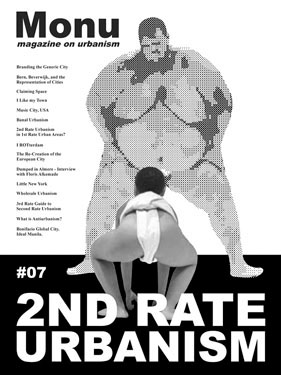





Order a copy of MONU #7 here.
(browse
the entire issue #7 on YouTube)
Branding
the Generic City by Alfredo Andia; Bern, Beverwijk, and the Representation
of Cities by Joost Meuwissen; Claiming Space by Daan and
Job Roggeveen; I like my Town by Medium; Music City, USA
by Veronica Kavass; Banal Urbanism by Jamie Peck; 2nd
Rate Urbanism in 1st Rate Urban Areas? by Doreen Jakob; I ROTterdam
by Charles Bessard and Nanne de Ru; The Re-Creation of the European
City by Beatriz Ramo/ STAR; Dumped in Almere - Interview
with Floris Alkemade/OMA by Bernd Upmeyer and Beatriz Ramo; Little
New York by Melisa Vargas; Wholesale Urbanism by Michael
Jenson; 3rd Rate Guide to Second Rate Urbanism by Alex Schafran;
What is Antiurbanism? by Michael J. Thompson; Bonifacio Global
City. Ideal Manila. by Ursula Faix/ bad architects group
In an increasingly connected world the economic realities are precarious for
most 2nd rate cities. In the competition for jobs and an ever expanding tax
base, 2nd rate cities are in a squeeze between the suburbs where land is even
cheaper and even more accessible by car on the one side, and the real attractive
1st rate urban areas that draw the highly educated and the creative on the other
side. And since planning ‘down’ to a suburb is not an option that
is considered by most cities, the fight for the survival of 2nd rate cities
is to attract more urban assets. Beatriz Ramo presents one such
Urban Shopping List for European second-rate cities. According
to the US-based urbanist Richard Florida the latest ‘must have’ for
a city is a creative class. In the information economy attracting those who
work in the creative sectors is the key to economic success and growth. However
as Jamie Peck in his article “Banal Urbanism –
Cities and the Creativity Fix” argues, this strategy is just another
way in which cities compete for an inherently mobile resource – the creatives
can at any time pack up and move to the next happening place. Plus the causal
story is far from solid, the cities investing in their hip factor as a development
strategy might well be chasing a chimera. But in the process they neglect those
neighborhoods and people that truly would need support. The creativity fix as
the business park of the new century. Second-rate cities are much more vulnerable
to adversarial politics and ideologies that promote suburbanization instead
of development of successful cities. Unlike cities of global format like New
York or Tokyo, they cannot create enough of an independent urban dynamic that
buffers them against anti-urban politics. Michael J. Thompson
traces the long history of an ideology that feeds much of these politics. Antiurbanism
– an ideology that demonizes urban life. For some concrete examples of
how these anti-urban politics can be directly reflected in concrete practices
look at Alex Schafran’s Unofficial Guide to 2nd Rate Urbanism.
(Bernd Upmeyer and Thomas Soehl, Editors, September 2007)
This issue is supported by the Creative
Industries Fund NL.
30-01-07 // MONU #6 - BEAUTIFUL URBANISM
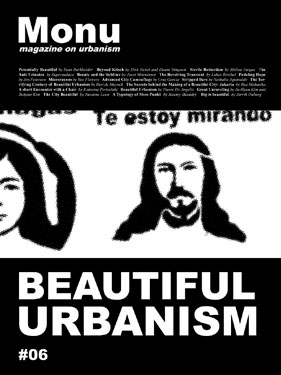





Order a copy of MONU #6 here.
(browse
the entire issue #6 on YouTube)
Potentially
Beautiful by Sean Burkholder; Beyond Kitsch by Dirk
Hebel and Deane Simpson; Sterile Rotterdam by Melisa Vargas;
The Anti-Urinator by Supersudaca; Beauty and the Sublime
by Joost Meuwissen; The Revolving Transient by Lukas
Reichel; Pedaling Hope by Jen Petersen; Microrayons
by Bee Flowers; Advanced City Camouflage by Cruz
Garcia; Stripped Bare by Nathalie Aguinaldo
The Terrifying Century of Beautiful Urbanism by Bert de Muynck;
The Secrets behind the Making of a Beautiful City: Jakarta by Ilya
Maharika; A short Encounter with a Chair by Katerina Pertselaki;
Beautiful Urbanism by Pierre De Angelis; Great Unraveling
by Ju-Hyun Kim and Bohyun Kim; The City Beautiful by Suzanne
Loen; A Typology of Mess Punkt by Jeremy Beaudry; Big
is Beautiful by Jarrik Ouburg
Even though the concept beauty remains elusive we think our issue is successful
in shining some spotlights on the issue. One of the themes from the articles
is that beauty in urbanism is what one could call an emergent quality. It rarely
is in the object itself. It exists in the way we perceive spaces and objects,
our vantage point. It is while wandering though the city, resolving contradictions,
when we see things that jolt our imaginations that we experience beauty. It
can be a small detail such as obscure dots on the sidewalk that German civil
engineers place all over the city to measure which propel Jeremy Beaudry
along daydreaming trajectories as he assembles the dotted pattern of Berlin.
Movement plays a central part, be it by bicycle as Jen Petersen
describes or in future cable cars that Lukas Reichelt invents.
Or within 30 years high resolution and real time aerial photography will open
yet another facade of the city to our perception – the view of the roofs
as Ju-Hyun Kim and Bohyun Kim predict. But if it is not all just
in our minds then there are some important tools for those who do care about
who and what it is that is built and declared beautiful – or left for us
to find the beauty in. How much leverage do we really have to imagine or stamp
that which is beautiful – if we must resolve ourselves between a complete
rejection of the sorts of beauty that seems to have many followers – Disney
architecture for example – to a naïve embracing of 30m high cowboy
boots? Can we go truly Beyond Kitsch as Dirk Hebel and Diane
Simpson suggest? Does the striving for a generic sense of beauty bear
even more serious repercussions as Ilya Maharika argues in his
study of Jakarta?
(Bernd Upmeyer and Thomas Soehl, Editors, January 2007)
This issue is supported by the Creative
Industries Fund NL.
10-07-06 // MONU #5 - BRUTAL URBANISM
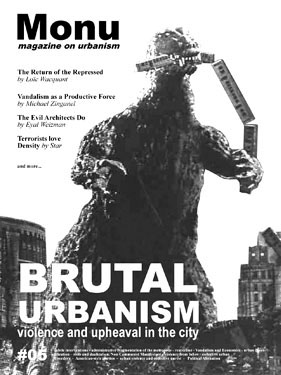





Order a copy of MONU #5 here.
(browse
the entire issue #5 on YouTube)
The Return of the Repressed by Loïc Wacquant; Vandalism
as a Productive Force by Michael Zinganel; The Evil Architects
Do by Eyal Weizman; Preventing Brutal Urbanism -
Interview with the Director of the Security Task Force for the 2006 World Cup
by Bernd Upmeyer; Terrorists Love Density by STAR;
The Future of June 4th by Austin Arensberg; Repulsive
Desperation in the Constructions of Survival by Baruch Bruce Gottlieb;
Happy Slapping - Urban Violance in the Age of Camera Phones
by Peter Mörtenböck and Helge Mooshammer; 5000
Years of Brutal Urbanism by UAS; It's the Protocol, Stupid
by Marc Schuilenburg; On the Run - Contesting Urban Boundaries
by Lukas Feireiss; Cities of Collision by Philipp
Misselwitz and Tim Rieniets; (re)Moving History by John
Comazzi; As a Child of the Suburbs: - a response to How Suburbs
Destroy Democracy by Alex Schafran; A Rejoinder to Alex
Schafran by Michael J. Thompson
Roughness, violence, brutality, seediness, ghettoization – all these
are words that we associate much more readily with the city than with a suburb
or the bucolic countryside. It seems even drug related crime develops a different
character depending on whether it is in the city or the suburb. As the NYTimes
reported in early July, identity theft is the crime of choice for meth addicts
and both are flourishing in suburban regions of the US. In contrast crack cocaine
or heroin dealers, are supported by heavily armed gangs usually set up in higher
density urban zones. These high density areas are suited to ‘urban’
crimes like, prostitution, carjacking and robbery. So the suburban habitat seems
perfectly suited for the sleepless meth-addict roaming through the internet,
garbage cans and outdoor mailboxes in a quest to gather identities, while the
density and proximity of a city is more fertile soil for the impulsiveness and
raw brutally that is typical for crack and cocaine criminality. In a similar
direction one of the directors of the World Cup 2006 security
in our interview echoed some thoughts that also show the relationships between
spatial configuration and the art of preventing urban brutality. These are just
some of the topics that this issue of Monu presents: Media representation and
context of brutality is one key aspect as our contributors show. Be it the possibility
to easily record and distribute via cell-phone cameras as Peter Moertenboek
and Helge Mooshammer describe in their article. Or the impossibility
to censor images of resistance as Austin Arensberg describes.
In our leading article Loic Wacquant analyzes the intensifying
of structural brutality in the city: economic, social and political exclusion
and the backlashes that inevitably follow. But brutality can also be an almost
integral part of the history of development, in some cities as articles about
places as different as Jerusalem and Seoul by Tim Rieniets
and Baruch Gottlieb respectively show.
(Bernd Upmeyer and Thomas Soehl, Editors, July 2006)
16-01-06 // MONU #4 - DENIED URBANISM
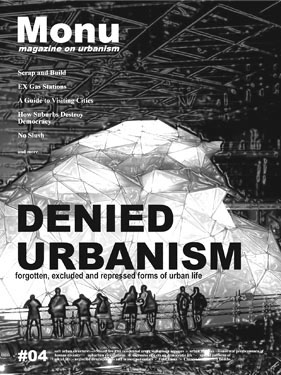





Order a copy of MONU #4 here.
(browse
the entire issue #4 on YouTube)
Scrap and Build by Yoshiharu Tsukamoto and Jorge Almazán;
Ex Gas Stations by UAS; Shopping for Vice
by Jeffrey Ludlow; The Future of Filming in Downtown Los Angeles
by Sarah Lorenzen; A Guide to Visiting Cities by Boris Sieverts;
The Master of Lockhart (Texas) by Hans Frei; Transforming Local
Government - privately by Robert H. Nelson; How Suburbs Destroy
Democracy by Michael J. Thompson; Literature of the City 101
by William Alatriste; No Simple Problem Interview by Martin
Schwegmann und Thorbjörn Reuter Christiansen with Mika Hannula; Infrascapes,
Urban Androgyny and other unplanned Effects of Metropolitan Dynamics by
Gabriel Duarte; No Slush by Tommi Mäkynen; E 70 by
Beatriz Ramo/ STAR; Reinventing Lifta by Malkit Shoshan
and Eitan Bronstein; Welcome to Houston, Texas by Eric Leshinsky;
The Heckpfad by Kai Dolata and Lola Meyer; Volkspalast by
Amelie Deuflhard and Sophie Krempl-Klieeisen; Hidden Veneration by
Kristina Blazevski; DIY by Matthijs Bouw
From Tokyo to Lockhart Texas, from suburbs and
informal settlements to the biggest representational buildings in capital cities,
from Helsinki to Jerusalem, this issue offers a
dazzling journey around the world to forms and episodes of urban life that have
one thing in common: they lead a precarious existence, in our perceptions and
in recognition of what is viable ‘urban’ life or - more drastically
- are actually threatened in their existence. It is not only le Corbusiers famous
“the eyes that cannot see” or don’t want to see, but sometimes
also that which the eyes do not want to see (any longer). However as many of
the contributions in this issue show clearly most of the time both of those
symptoms of denying urbanism are happening simultaneously and are faces of the
same coin. And the blindness and ignorance seems to be global and escapes narrow
definitions of political ideology and even the categories of benevolent planners.
Preservation of buildings and the neglect of destruction does not necessarily
protect urban life – quite the opposite as Yoshiharu Tsukamoto and
Jorge Almazán suggest in their article about Tokyo.
More dramatically, historic preservation or reconstruction can also be a strategy
to rewrite the history of a place, as if to erase the traces of another population
as is happening in Lifta - Israel. Size does not matter for the
concept of denied urbanism – at least looking at the contributions. A small
informal settlement on the fringes of the inner city of Cologne
can be subject to the same mix of willful ignorance and the desire to create
a clean city just as the Palast der Republik in Berlin
– the biggest representational building of the former GDR. More often than
not there are many sides from which one can see the denial. On the one hand
Suburbia – the denying of urban life has profound negative consequences
for democracy as Michael Thompson argues. On the other hand Michael
Nelson sees potential in home owner associations as a particular form
of governance that is massively emerging in suburban contexts and that is widely
ignored at least among the mainstream planning community.
(Bernd Upmeyer and Thomas Soehl, Editors, January 2006)
05-07-05 // MONU #3 - POLITICAL URBANISM
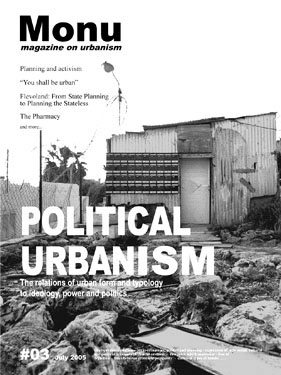




Sold out.
(browse
the entire issue #3 on YouTube)
Planning and Activism by Malkit Shoshan; nEUtral
by bad-architects; Rojak by Maggie Peng; Between Aerial
Defense and Modernism by Lola Meyer; Model City - Interview
with Margitta Faßl, the managing director of 'Wohnungsgesellschaft Hoyerswerda'
by Bernd Upmeyer; You shall be Urban by Theo Deutinger;
Flevoland: From State Planning to Planning the Stateless by
CASE; The Pharmacy by Joost Meuwissen; Turning the Corner
by Fabian Faltin; Supersuburbia by UAS
Exploring the relationship between power, politics and cities, urban territories
is like looking at the chicken and egg question. What grows out of what? In
Hoyerswerda, a middle sized east-German city where we spoke to
Margitta Fassl, the Managing Director of the largest housing authority
(that manages about 60x% of the cities housing units), the situation seems clear.
The city over the last 50 years has been a ball on the waves of larger economic
and political developments. From a small town of about 7,000 people, Hoyerswerda
was built up into a model city the socialist era with about 70,000 people, now
to its status is being a model amongst the shrinking cities in Eastern
Germany that wither in the new market economics. Like clockwork is house
after house demolished. There remain approximately 40,000 residents and the
city is expected to lose at least another 10,0000 in the coming years. Hoyerswerda
came to tragic fame in the early 90's when a racist, xenophobic mob and dozens
of neo-nazis repeatedly attacked immigrants and engaged in violent street fights
with the police. Ultimately the discussion about the relation between urban
form and urban development, to politics and power, has a large impact on the
self-understanding of the professions that deal with these topics. Are we as
architects, planners, social scientists etc. mere 'hostages', as Rem Koolhaas
expressed it at one point, of larger economic and political contexts, or can
planning, research and building actually be activism, a contribution to a struggle
to change things? Malkit Shoshan in her truly extraordinary project
in a village in Israel in a way answers this question. Her account
of the project in "Planning and Activism" shows how
research in urban planning combined with an effort to engage stakeholders and
powerbrokers can actually be a powerful political act.
(Bernd Upmeyer and Thomas Soehl, Editors, July 2005)
20-01-05 // MONU #2 - MIDDLE CLASS URBANISM
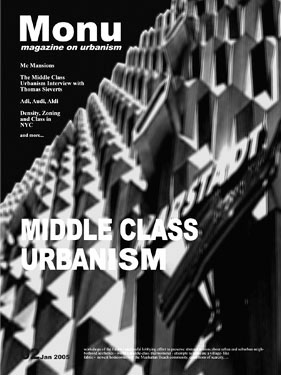





Sold out.
(browse
the entire issue #2 on YouTube)
Dispersion by Johannes Fiedler; Density, Zoning, and Class
in New York City by Beth Lieberman; Mc Mansions by William
Alatriste; Urbanism for the Middle Class in historic City Centers
by Fernando Vegas and Camilla Mileto; Middle Class Urbanism
Interview - with Thomas Sieverts by Bernd Upmeyer ; IKEA:
When Cathedrals were blue by Manuel Shvartzberg; Neu Karow:
a new space between berlin's past and its border by Katherine Bourke
and Gregor Harbusch; Landscape Urbanism by Detlev Ipsen and Holger
Weichler; Circuitous by Leah Beeferman; Adi,
Audi, Aldi by Theo Deutinger; Middle Class Emulations by
Angie Waller; The New Middle Class by Robert Winkel;
Middle Class Desires by UAS
For the last few decades the middle class has been the driving force behind
urban innovation. More than any other, this urban group has both the financial
resources and the sheer power of numbers to effectively transform desire into
urban reality. Many of the most obvious components of our cities - Row houses,
apartment buildings and sports facilities, to name but a few - are in large
measure a function of the existence of a broad middle class. The middle class
symbolizes modest urban values, values that seem hopelessly anti-utopian and
run counter to the megalomaniac concepts of cities proposed by great architects
like LeCorbusier or Hilbersheimer. But in reality the middle class
is comprised of some of the boldest urban utopists ever, individuals who have
been realizing their utopias for decades. Much less dogmatic and more successful
than any imagined utopia, with their power, influence and sheer numbers the
middle class has shaped the urban landscapes we inhabit today. And although
the term middle class is very blurry it might be exactly the contradictory relation
of middle class to cities that could lead to a definition of what is the middle-class.
As Johannes Fiedler argues in his text "Dispersion",
in the absence of scarcity of some sort (e.g. economic, security) or top-down
regulations, the default choice for living seem to be dispersed, low density
environments. Or as Thomas Sieverts in our interview put it:
"people seek the fringes". It is almost a pioneer-like quality
that parts of the middle class exhibit – the constant search for the new
fringe, the new land. The relatively new phenomenon of exurbs is the US expression
of that impulse. Places that are ever further removed from the population centers
almost completely disconnected from any form of civic life. In Europe or Germany
this strategy is not an option due to lack of available open space. Instead
in Berlin, as documented in the article by Katherine Bourke
and Gregor Harbusch, spaces in between old and new cities are the new
frontier – the new fringe that the middle-class colonizes.
(Bernd Upmeyer and Thomas Soehl, Editors, January 2005)
16-06-04 // MONU #1 - PAID URBANISM
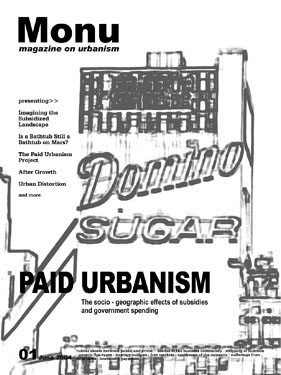




Order a copy of MONU #1 here.
(browse
the entire issue #1 on YouTube)
Imagining the Subsidized Landscape by CUP; After Growth
by CASE with Reinier de Graaf; Urban Distortion by
Shireen A. Barday and Damon W. Root; Urban Money Beats Global Money
by Hans-Henning von Winning; The Paid Urbanism Project by
Thomas Soehl and Bernd Upmeyer; SpaMania by Kai Jonas; Is
a Bathtub Still a Bathtub on Mars? by William Alatriste; Richard
J. Daley’s Chicago Civic Center and the Modernist Urban Landscape
by Emily Pugh
Our experience of urban life today exists as it does because we have a complex
system of subsidies interacting with our urban geography. Taxes, once extracted
from the market economy cycle back to the masses as paid urbanism. Used wisely
or not, spread fairly or unfairly, this money is probably one of the strongest
forces animating our urban conditions today. The places we live in today are
in many ways shaped by government spending - Subsidized Landscapes. Since the
‘90s, big enthusiasm about total privatization has subsided. Nowadays,
everybody realizes that there is a need to keep certain things in the hand of
public administration. Redistribution of enormous revenue is a commonly accepted
means of keeping civil democratic societies working. Government intervention,
taxing and spending are the terms we use to describe this state. Caught in an
enormous network of redistribution that pervades everything and everybody, the
power and influence of these processes rarely makes itself visible; we are never
fully aware. A Kafkaesque web of bureaucracies constantly recreates
and resuscitates our urban landscapes. Drifting through cities with their thousands
of invisible dependencies and relationships, no one person can exactly define
what keeps everything alive. Everything seems to be vibrant, but somewhere down
the line, there are crosscutting streams and flows of decisions and administration
behind it. It has been paid for. The multitudinous products of paid urbanism
are hard to identify or define, but lie hidden behind every stone of the city.
The effects of paid urbanism on urban settings cannot be overemphasized - without
paid urbanism, cities as we know them would not exist. This first issue shines
a number of spotlights into the thicket of subsidies and paid urbanism. What
do networks of subsidies look like in fields like housing and farming in the
US and what are their consequences for cities? What are the aesthetic impacts
and absurdities of paid urbanism in places as different as Chicago, Coney
Island (NYC) and Thuringen (eastern Germany). We feature projects that
rethink the networks of paid urbanism and essays that reflect on the interwoven
history of subventions and urbanism.
(Bernd Upmeyer and Thomas Soehl, Editors, June 2004)





















































































































































































































































